Paul van Yperen's Blog, page 376
July 18, 2015
Albert Paulig
Albert Paulig (1873-1933) was a popular comedian in the German silent cinema of the 1910s and 1920s.
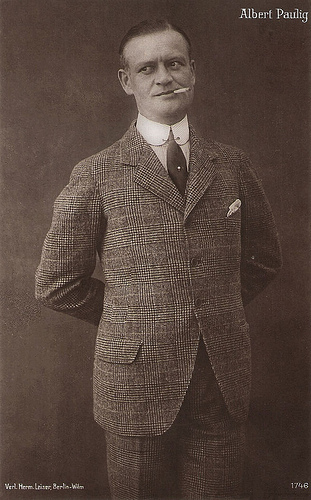
German postcard by Verl. Herm. Leiser, Berlin-Wilm., no. 1746.
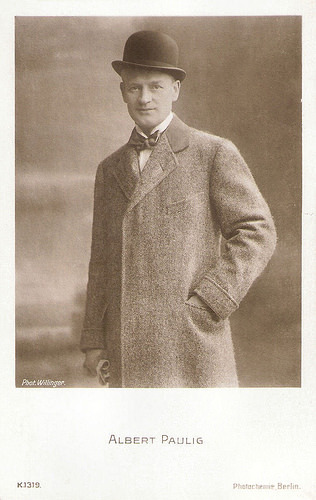
German postcard by Photochemie, Berlin, no. K. 1319. Photo: Willinger.
His Own Comedy Series
Born in Stollberg, Germany in 1873, Albert Paulig was trained to become a teacher. He also did a musical training at the Konservatorium Dresden (conservatory of Dresden), but initially he became a salesman.
In 1896 he had his stage debut at the Stadttheater in Zwickau. Other locations he performed were Łódź, Hannover and Dresden. In 1901 he first performed in Berlin at the Deutsch-Amerikanischen Theater, after which he did several guest performances in other Berlin stages.
In 1913, when he was already 40, Albert Paulig was discovered as a film comedian. Because of his success he got his own series in the 1910s, the Albert-Paulig series, with titles just as simple as Paulig als Asta Nielsen/Paulig as Asta Nielsen (Albert Paulig, 1915) or Albert hat Prokura/Albert has the power of attorney (Uwe Jenss Kraft, 1919).
Starting with Alberts Hose/Albert’s Pants (1915), Paulig directed his own comedy series. But in between he also acted in films by other directors.
Paulig for example played opposite Ernst Lubitsch in both the popular success Die Firma heiratet/The Firm Weds (Carl Wilhelm, 1914) and its unofficial sequel Der Stolz der Firma/The Pride of the Firm (Carl Wilhelm, 1914). He also co-starred with Hanni Weisse in Meine Braut, seine Frau/My bride, his wife (Danny Kaden, 1916).
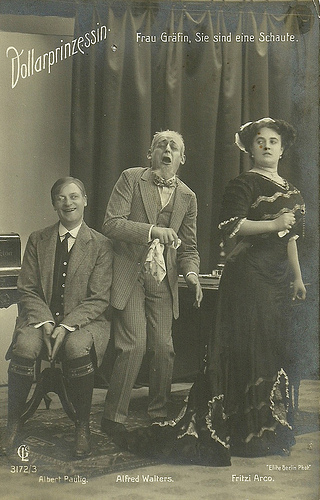
German postcard by G.L., no. 3172/3. Photo: Elite, Berlin. Albert Paulig, Alfred Walters and Fritzi Arco in the operetta Die Dollarprinzessin (The dollar princess). This operetta by Leo Fall was first performed in Vienna in 1907, this card is for the Berlin version of 1908.
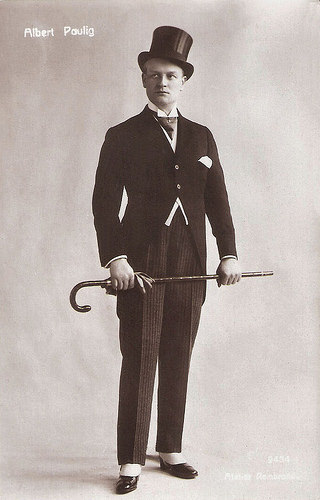
German postcard, no. 9434. Photo: Atelier Rembrandt.
Strong Popularity
After he stopped his Albert-Paulig series in 1919, Paulig’s popularity remained strong among audiences. During the 1920s, he acted in over 100 films. While Albert Paulig mostly performed in supporting parts, he sometimes had major parts as the protagonist or the main antagonist.
Albert Paulig co-starred with Mia May and Georg Alexander in the comedy Die platonische Ehe/The platonic marriage (Paul Leni, 1919), and acted with Hans Albers and Ria Jende in Der Schuss aus dem Fenster/The shot out the window (director unknown, 1920).
He did several small parts in the Ossi Oswalda comedies of the late 1910s and early 1920s such as Das Mädchen aus dem wilden Westen/The girl from the Wild West (Erich Schönfelder, 1921). The most famous example is the classic Die Austernprinzessin/The Oyster Princess ( Ernst Lubisch , 1919).
Paulig was reunited with Hanni Weisse in the comedy Weil Du es bist/Because it's you (Hans Werckmeister, 1925). He had the lead as Archduke Albert Paul in G’schichten aus dem Wienerwald/Tales from the Vienna Woods (Jaap Speyer, 1928), co-starring Eric Barclay, Magnus Stifter and Fritz Schulz .
In the later 1920s, he was often seen in supporting parts in the sensational Harry Piel adventure films, such as Der Mann ohne Nerven/The Man Without Nerves (Harry Piel, 1924), Zigano, der Brigant vom Monte Diavolo/Zigano ( Harry Piel , 1925), Sein grösster Bluff/His Greatest Bluff ( Harry Piel , 1927), Panik/Panic ( Harry Piel , 1928), and Männer ohne Beruf/Men without Profession ( Harry Piel , 1929).
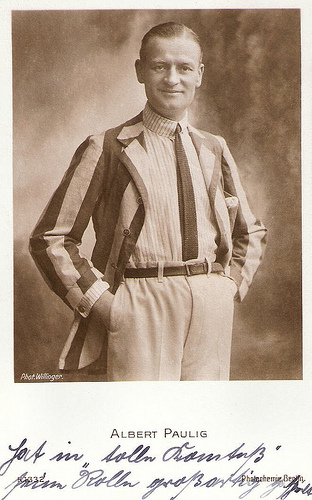
German postcard by Photochemie, no. K. 1332. Berlin. Photo: Willinger.
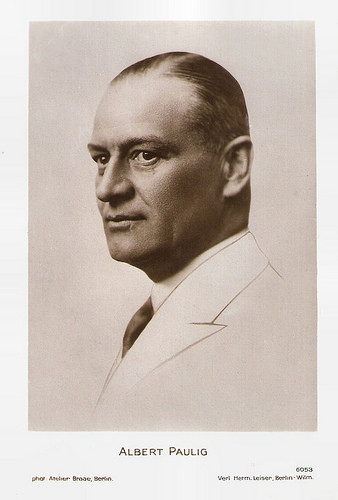
German postcard by Verl. Herm. Leiser, Berlin-Wilm., no. 6053. Berlin. Photo: Atelier Binder, Berlin.
Army Officers
When sound film set in, Paulig managed to continue his career, often portraying aristocrats and industrials, but in particular army officers. An example of the latter is Schön is die Manöverzeit/Manoeuver Time Is Fine (Erich Schönfelder, Margarete Schön, 1931) with Ida Wüst .
He also acted the musical Es war einmal ein Walzer/Once There Was a Waltz (Victor Janson, 1932) written by Billy Wilder, Der Prinz von Arkadien/The Prince from Arcadien (Karl Hartl, 1932) with Willi Forst , Das Testament des Cornelius Gulden/The Testament of Cornelius Gulden (E.W. Emo, 1932), starring Magda Schneider and Georg Alexander , and Manolescu, der Fürst der Diebe/Manolescu (George C. Klaren, Willi Wolff, 1933), starring Iván Petrovich .
The crime film K1 greift ein/K1 intervenes (Edmund Heuberger, 1933) was his last film. He couldn’t attend the premiere of the film, as he died himself in Berlin on 19 March 1933, because of a heart failure, two days after the film had passed censorship. According to Filmportal.de , which lists his most extended filmography, Albert Paulig acted in 183 films.
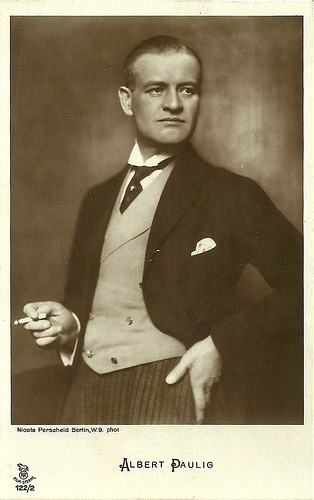
German postcard in the Film-Sterne series by Rotophot, no. 122/2. Photo: Nicola Perscheid, Berlin. Ca. 1916-1918.
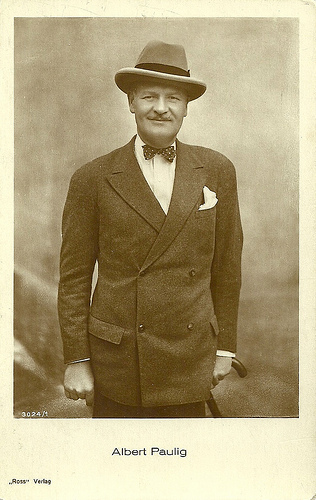
German postcard by Ross Verlag, no. 3024/1, 1928-1929.
Sources: Filmportal.de, Wikipedia (German and English), and .

German postcard by Verl. Herm. Leiser, Berlin-Wilm., no. 1746.

German postcard by Photochemie, Berlin, no. K. 1319. Photo: Willinger.
His Own Comedy Series
Born in Stollberg, Germany in 1873, Albert Paulig was trained to become a teacher. He also did a musical training at the Konservatorium Dresden (conservatory of Dresden), but initially he became a salesman.
In 1896 he had his stage debut at the Stadttheater in Zwickau. Other locations he performed were Łódź, Hannover and Dresden. In 1901 he first performed in Berlin at the Deutsch-Amerikanischen Theater, after which he did several guest performances in other Berlin stages.
In 1913, when he was already 40, Albert Paulig was discovered as a film comedian. Because of his success he got his own series in the 1910s, the Albert-Paulig series, with titles just as simple as Paulig als Asta Nielsen/Paulig as Asta Nielsen (Albert Paulig, 1915) or Albert hat Prokura/Albert has the power of attorney (Uwe Jenss Kraft, 1919).
Starting with Alberts Hose/Albert’s Pants (1915), Paulig directed his own comedy series. But in between he also acted in films by other directors.
Paulig for example played opposite Ernst Lubitsch in both the popular success Die Firma heiratet/The Firm Weds (Carl Wilhelm, 1914) and its unofficial sequel Der Stolz der Firma/The Pride of the Firm (Carl Wilhelm, 1914). He also co-starred with Hanni Weisse in Meine Braut, seine Frau/My bride, his wife (Danny Kaden, 1916).

German postcard by G.L., no. 3172/3. Photo: Elite, Berlin. Albert Paulig, Alfred Walters and Fritzi Arco in the operetta Die Dollarprinzessin (The dollar princess). This operetta by Leo Fall was first performed in Vienna in 1907, this card is for the Berlin version of 1908.

German postcard, no. 9434. Photo: Atelier Rembrandt.
Strong Popularity
After he stopped his Albert-Paulig series in 1919, Paulig’s popularity remained strong among audiences. During the 1920s, he acted in over 100 films. While Albert Paulig mostly performed in supporting parts, he sometimes had major parts as the protagonist or the main antagonist.
Albert Paulig co-starred with Mia May and Georg Alexander in the comedy Die platonische Ehe/The platonic marriage (Paul Leni, 1919), and acted with Hans Albers and Ria Jende in Der Schuss aus dem Fenster/The shot out the window (director unknown, 1920).
He did several small parts in the Ossi Oswalda comedies of the late 1910s and early 1920s such as Das Mädchen aus dem wilden Westen/The girl from the Wild West (Erich Schönfelder, 1921). The most famous example is the classic Die Austernprinzessin/The Oyster Princess ( Ernst Lubisch , 1919).
Paulig was reunited with Hanni Weisse in the comedy Weil Du es bist/Because it's you (Hans Werckmeister, 1925). He had the lead as Archduke Albert Paul in G’schichten aus dem Wienerwald/Tales from the Vienna Woods (Jaap Speyer, 1928), co-starring Eric Barclay, Magnus Stifter and Fritz Schulz .
In the later 1920s, he was often seen in supporting parts in the sensational Harry Piel adventure films, such as Der Mann ohne Nerven/The Man Without Nerves (Harry Piel, 1924), Zigano, der Brigant vom Monte Diavolo/Zigano ( Harry Piel , 1925), Sein grösster Bluff/His Greatest Bluff ( Harry Piel , 1927), Panik/Panic ( Harry Piel , 1928), and Männer ohne Beruf/Men without Profession ( Harry Piel , 1929).

German postcard by Photochemie, no. K. 1332. Berlin. Photo: Willinger.

German postcard by Verl. Herm. Leiser, Berlin-Wilm., no. 6053. Berlin. Photo: Atelier Binder, Berlin.
Army Officers
When sound film set in, Paulig managed to continue his career, often portraying aristocrats and industrials, but in particular army officers. An example of the latter is Schön is die Manöverzeit/Manoeuver Time Is Fine (Erich Schönfelder, Margarete Schön, 1931) with Ida Wüst .
He also acted the musical Es war einmal ein Walzer/Once There Was a Waltz (Victor Janson, 1932) written by Billy Wilder, Der Prinz von Arkadien/The Prince from Arcadien (Karl Hartl, 1932) with Willi Forst , Das Testament des Cornelius Gulden/The Testament of Cornelius Gulden (E.W. Emo, 1932), starring Magda Schneider and Georg Alexander , and Manolescu, der Fürst der Diebe/Manolescu (George C. Klaren, Willi Wolff, 1933), starring Iván Petrovich .
The crime film K1 greift ein/K1 intervenes (Edmund Heuberger, 1933) was his last film. He couldn’t attend the premiere of the film, as he died himself in Berlin on 19 March 1933, because of a heart failure, two days after the film had passed censorship. According to Filmportal.de , which lists his most extended filmography, Albert Paulig acted in 183 films.

German postcard in the Film-Sterne series by Rotophot, no. 122/2. Photo: Nicola Perscheid, Berlin. Ca. 1916-1918.

German postcard by Ross Verlag, no. 3024/1, 1928-1929.
Sources: Filmportal.de, Wikipedia (German and English), and .
Published on July 18, 2015 22:00
July 17, 2015
Goldfinger (1964)
Goldfinger (Guy Hamilton, 1964) is the quintessential episode in the James Bond series, filled with thrills, girls and danger. It was the third episode and the third to star suave and ultra-cool Sean Connery as agent 007. Everything seemed to be right, the stunts, the sets, the score, the gadgets, and a wonderful cast. The film co-stars Honor Blackman as Pussy Galore, Gert Fröbe as Auric Goldfinger, and Shirley Eaton as the iconic Bond girl Jill Masterson.
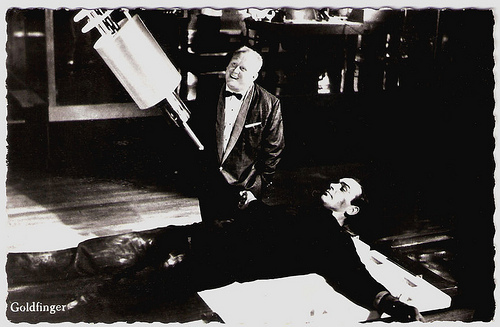
Dutch postcard. Sent by mail in 1966. Publicity still for Goldfinger (1964) with Sean Connery and Gert Fröbe. "Do you expect me to talk, Goldfinger?" Bond asks as the laser beam slowly makes its way towards his groin. "No, Mr. Bond, I expect you to die!" Goldfinger answers.
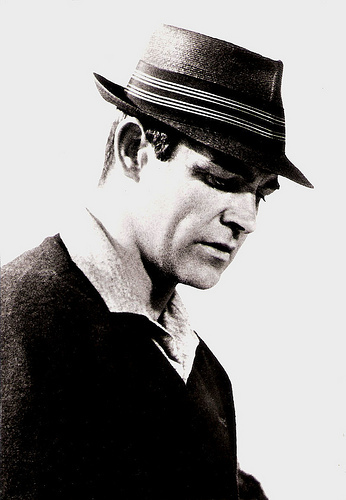
Dutch card, no. AX 6263. Publicity still for Goldfinger (Guy Hamilton, 1964).
Not inside Fort Knox
Goldfinger was based again on a novel by Ian Fleming. There isn't much of a plot, really. James Bond is investigating gold smuggling by gold magnate Auric Goldfinger and eventually uncovering Goldfinger's plans to contaminate the Fort Knox gold reserve.
Producers were Albert R. Broccoli and Harry Saltzman. Goldfinger had what was then considered a large budget of $3 million (US$22,812,232 in 2015 dollars), the equivalent of the budgets of Dr. No (Terence Young, 1962) and From Russia with Love (Terence Young, 1963) combined, and was the first James Bond film classified as a box-office blockbuster.
Goldfinger saw the return of two crew members who were not involved with From Russia With Love: stunt coordinator Bob Simmons and production designer Ken Adam. Both played crucial roles in the development of Goldfinger. Simmons choreographed the fight sequence between Bond and Oddjob (Harold Sakata) in the vault of Fort Knox, one of the best Bond fights.
For security reasons, the filmmakers were not allowed to film inside Fort Knox, although exterior photography was permitted. All sets for the interiors were designed and built from scratch at Pinewood Studios. The filmmakers had no clue as to what the interior of the depository looked like, so Ken Adam's imagination provided the idea of gold stacked upon gold behind iron bars. Harry Saltzman disliked the design's resemblance to a prison, but Guy Hamilton liked it enough that it was built. The comptroller of Fort Knox later sent a letter to Adam and the production team, complimenting them on their imaginative depiction of the vault.
Principal photography took place from January to July 1964 in the United Kingdom, Switzerland and the U.S. states of Kentucky and Florida. The opening credit sequence was designed by graphic artist Robert Brownjohn, featuring clips of all James Bond films thus far projected on actress Margaret Nolan's body. Its design was inspired by seeing light projecting on people's bodies as they got up and left a cinema. Brownjohn was also responsible for the posters for the advertising campaign, which also used Nolan.
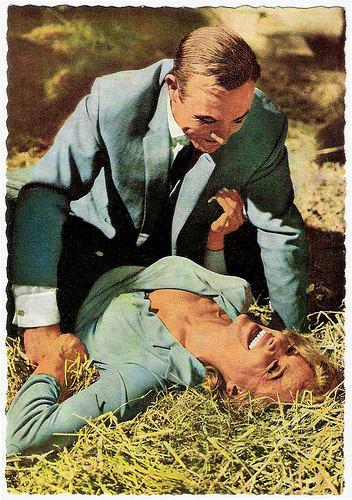
German postcard. Photo: P.A. Reuter. Publicity still for Goldfinger (Guy Hamilton, 1964) with Sean Connery and Honor Blackman .
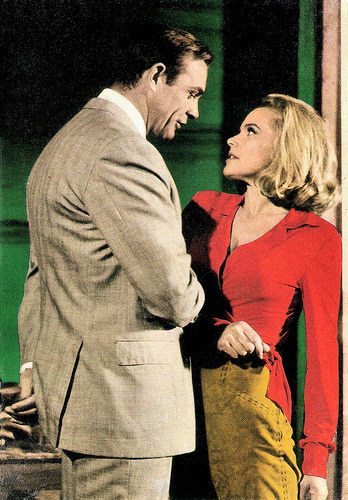
Spanish postcard by Postal Oscarcolor, no. 355. Photo: publicity still for Goldfinger (Guy Hamilton, 1964) with Sean Connery and Honor Blackman .
Pussy Galore
Honor Blackman played Pussy Galore, Goldfinger's personal pilot and leader of an all-female team of pilots known as Pussy Galore's Flying Circus. Blackman was selected for the role of Pussy Galore because of her role as Cathy Gale in the classic British TV series The Avengers (1962-1964) and the script was rewritten to show Blackman's judo abilities. The character's name follows in the tradition of other Bond girls names that are double entendres. During promotion, Blackman took delight in embarrassing interviewers by repeatedly mentioning the character's name.
Gert Fröbe was excellent as Bond villain Auric Goldfinger, the 'international cheat, international menace' obsessed with gold. Orson Welles was considered as Goldfinger, but his financial demands were too high. Fröbe was cast because the producers saw his performance as a child molester in the German film Es geschah am hellichten Tag/It Happened in Broad Daylight (Ladislao Vajda, 1958). Fröbe, who spoke little English, said his lines phonetically.
British actress Shirley Eaton played Jill Masterson, Bond Girl and Goldfinger's aide-de-camp. Bond catches her helping the villain cheat at a game of cards. He seduces her, but for her betrayal, she is completely painted in gold paint and dies from "skin suffocation". Although only a small part in the film, the image of her painted gold was renowned and Eaton graced the cover of Life magazine of 6 November 1964.
And Goldfinger was also the first of the Bond films to feature Q (Desmond Llewelyn). In From Russia with Love (Terence Young, 1963) Llewelyn had played the role of Major Boothroyd. Q became the beloved comic relief figure of the series and Llewellyn appeared in 17 James Bond films until his death in 1999. He was absent in Live and Let Die (Guy Hamilton, 1973), because producers felt too much attention was being paid on the gadgetry so they downplayed it by cutting his role. However, audiences enjoyed Q so much that Llewelyn was brought back indefinitely.
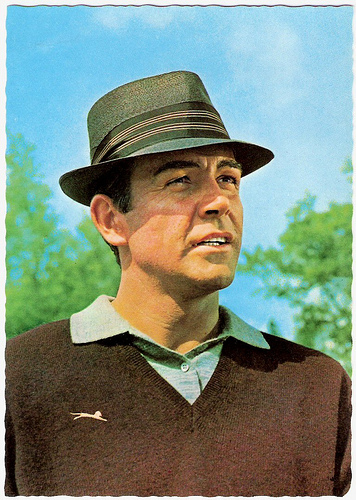
German postcard by ISV, no. H 119. Publicity still for Goldfinger (Guy Hamilton, 1964).
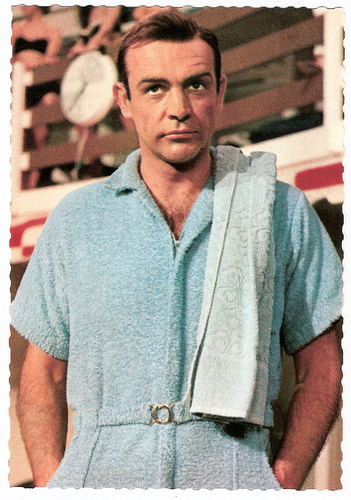
German postcard by ISV, no. H 123. Publicity still for Goldfinger (Guy Hamilton, 1964).
Goldfinger began to up the ante
Shirley Bassey sang the theme song Goldfinger, and she would go on to sing the theme songs for two other Bond films, Diamonds are Forever (Guy Hamilton, 1971) and Moonraker (Lewis Gilbert, 1979). The song was composed by John Barry, with lyrics by Anthony Newley and Leslie Bricusse.
Goldfinger was the first of the series to feature the famous line, "Bond, James Bond," as a 007 catchphrase. It also featured the most famous James Bond car, the 1964 silver birch Aston Martin DB5, was introduced in Goldfinger. To promote the film, the two Aston Martin DB5s were showcased at the 1964 New York World's Fair. It was dubbed 'the most famous car in the world', and sales of the car rose.
Corgi Toys began a decades-long relationship with the Bond franchise, producing a toy of the car, which became the biggest selling toy of 1964. The film's success also led to licensed tie-in clothing, dress shoes, action figures, board games, jigsaw puzzles, lunch boxes, toys, record albums, slot cars, and postcards.
Lucia Bozzola at AllMovie : "Goldfinger set the gold standard (naturally) for future James Bond adventures. With the films' signature elements firmly entrenched - including globe-trotting story, salacious credits sequence, Q's exasperation, and 007's phenomenal abilities with women and antagonists - Goldfinger began to up the ante. Bond's well-equipped Aston-Martin and Goldfinger's elaborate Fort Knox model presaged future technical extravagance, while Bond's near castration via a giant laser was one more sign of the series' humorous self-awareness."
Goldfinger became the first Bond film to win an Academy Award. At the 1965 Academy Awards, Norman Wanstall won the Academy Award for Best Sound Effects Editing for his work. Ken Adam was nominated for the British Academy of Film and Television Arts (BAFTA) for Best British Art Direction (Colour). The film opened to largely favourable critical reception and was a financial success. Goldfinger 's $3 million budget was recouped in two weeks, and it broke box office records in multiple countries around the world.
Official trailer Goldfinger (1964). Source: MoviesHistory (YouTube).
The title sequence by Robert Brownjohn. Source: juanmurs (YouTube).
Sources: Lucia Bozzola (AllMovie), Wikipedia and IMDb.

Dutch postcard. Sent by mail in 1966. Publicity still for Goldfinger (1964) with Sean Connery and Gert Fröbe. "Do you expect me to talk, Goldfinger?" Bond asks as the laser beam slowly makes its way towards his groin. "No, Mr. Bond, I expect you to die!" Goldfinger answers.

Dutch card, no. AX 6263. Publicity still for Goldfinger (Guy Hamilton, 1964).
Not inside Fort Knox
Goldfinger was based again on a novel by Ian Fleming. There isn't much of a plot, really. James Bond is investigating gold smuggling by gold magnate Auric Goldfinger and eventually uncovering Goldfinger's plans to contaminate the Fort Knox gold reserve.
Producers were Albert R. Broccoli and Harry Saltzman. Goldfinger had what was then considered a large budget of $3 million (US$22,812,232 in 2015 dollars), the equivalent of the budgets of Dr. No (Terence Young, 1962) and From Russia with Love (Terence Young, 1963) combined, and was the first James Bond film classified as a box-office blockbuster.
Goldfinger saw the return of two crew members who were not involved with From Russia With Love: stunt coordinator Bob Simmons and production designer Ken Adam. Both played crucial roles in the development of Goldfinger. Simmons choreographed the fight sequence between Bond and Oddjob (Harold Sakata) in the vault of Fort Knox, one of the best Bond fights.
For security reasons, the filmmakers were not allowed to film inside Fort Knox, although exterior photography was permitted. All sets for the interiors were designed and built from scratch at Pinewood Studios. The filmmakers had no clue as to what the interior of the depository looked like, so Ken Adam's imagination provided the idea of gold stacked upon gold behind iron bars. Harry Saltzman disliked the design's resemblance to a prison, but Guy Hamilton liked it enough that it was built. The comptroller of Fort Knox later sent a letter to Adam and the production team, complimenting them on their imaginative depiction of the vault.
Principal photography took place from January to July 1964 in the United Kingdom, Switzerland and the U.S. states of Kentucky and Florida. The opening credit sequence was designed by graphic artist Robert Brownjohn, featuring clips of all James Bond films thus far projected on actress Margaret Nolan's body. Its design was inspired by seeing light projecting on people's bodies as they got up and left a cinema. Brownjohn was also responsible for the posters for the advertising campaign, which also used Nolan.

German postcard. Photo: P.A. Reuter. Publicity still for Goldfinger (Guy Hamilton, 1964) with Sean Connery and Honor Blackman .

Spanish postcard by Postal Oscarcolor, no. 355. Photo: publicity still for Goldfinger (Guy Hamilton, 1964) with Sean Connery and Honor Blackman .
Pussy Galore
Honor Blackman played Pussy Galore, Goldfinger's personal pilot and leader of an all-female team of pilots known as Pussy Galore's Flying Circus. Blackman was selected for the role of Pussy Galore because of her role as Cathy Gale in the classic British TV series The Avengers (1962-1964) and the script was rewritten to show Blackman's judo abilities. The character's name follows in the tradition of other Bond girls names that are double entendres. During promotion, Blackman took delight in embarrassing interviewers by repeatedly mentioning the character's name.
Gert Fröbe was excellent as Bond villain Auric Goldfinger, the 'international cheat, international menace' obsessed with gold. Orson Welles was considered as Goldfinger, but his financial demands were too high. Fröbe was cast because the producers saw his performance as a child molester in the German film Es geschah am hellichten Tag/It Happened in Broad Daylight (Ladislao Vajda, 1958). Fröbe, who spoke little English, said his lines phonetically.
British actress Shirley Eaton played Jill Masterson, Bond Girl and Goldfinger's aide-de-camp. Bond catches her helping the villain cheat at a game of cards. He seduces her, but for her betrayal, she is completely painted in gold paint and dies from "skin suffocation". Although only a small part in the film, the image of her painted gold was renowned and Eaton graced the cover of Life magazine of 6 November 1964.
And Goldfinger was also the first of the Bond films to feature Q (Desmond Llewelyn). In From Russia with Love (Terence Young, 1963) Llewelyn had played the role of Major Boothroyd. Q became the beloved comic relief figure of the series and Llewellyn appeared in 17 James Bond films until his death in 1999. He was absent in Live and Let Die (Guy Hamilton, 1973), because producers felt too much attention was being paid on the gadgetry so they downplayed it by cutting his role. However, audiences enjoyed Q so much that Llewelyn was brought back indefinitely.

German postcard by ISV, no. H 119. Publicity still for Goldfinger (Guy Hamilton, 1964).

German postcard by ISV, no. H 123. Publicity still for Goldfinger (Guy Hamilton, 1964).
Goldfinger began to up the ante
Shirley Bassey sang the theme song Goldfinger, and she would go on to sing the theme songs for two other Bond films, Diamonds are Forever (Guy Hamilton, 1971) and Moonraker (Lewis Gilbert, 1979). The song was composed by John Barry, with lyrics by Anthony Newley and Leslie Bricusse.
Goldfinger was the first of the series to feature the famous line, "Bond, James Bond," as a 007 catchphrase. It also featured the most famous James Bond car, the 1964 silver birch Aston Martin DB5, was introduced in Goldfinger. To promote the film, the two Aston Martin DB5s were showcased at the 1964 New York World's Fair. It was dubbed 'the most famous car in the world', and sales of the car rose.
Corgi Toys began a decades-long relationship with the Bond franchise, producing a toy of the car, which became the biggest selling toy of 1964. The film's success also led to licensed tie-in clothing, dress shoes, action figures, board games, jigsaw puzzles, lunch boxes, toys, record albums, slot cars, and postcards.
Lucia Bozzola at AllMovie : "Goldfinger set the gold standard (naturally) for future James Bond adventures. With the films' signature elements firmly entrenched - including globe-trotting story, salacious credits sequence, Q's exasperation, and 007's phenomenal abilities with women and antagonists - Goldfinger began to up the ante. Bond's well-equipped Aston-Martin and Goldfinger's elaborate Fort Knox model presaged future technical extravagance, while Bond's near castration via a giant laser was one more sign of the series' humorous self-awareness."
Goldfinger became the first Bond film to win an Academy Award. At the 1965 Academy Awards, Norman Wanstall won the Academy Award for Best Sound Effects Editing for his work. Ken Adam was nominated for the British Academy of Film and Television Arts (BAFTA) for Best British Art Direction (Colour). The film opened to largely favourable critical reception and was a financial success. Goldfinger 's $3 million budget was recouped in two weeks, and it broke box office records in multiple countries around the world.
Official trailer Goldfinger (1964). Source: MoviesHistory (YouTube).
The title sequence by Robert Brownjohn. Source: juanmurs (YouTube).
Sources: Lucia Bozzola (AllMovie), Wikipedia and IMDb.
Published on July 17, 2015 16:27
July 16, 2015
Pascal Lamorisse
French child actor Pascal Lamorisse (1950) is known by film lovers all over the world because of his parts in the short films Crin blanc: Le cheval sauvage (1953) and Le ballon rouge (1956), both directed by his father, Albert Lamorisse.
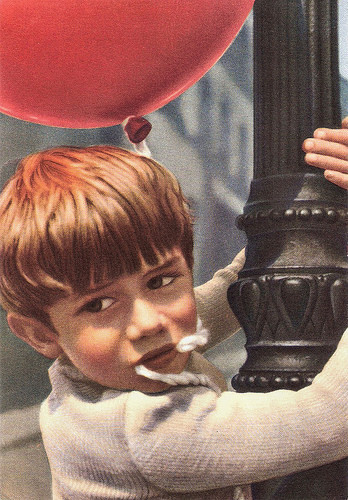
Italian postcard in the series Piccoli uomini nel cinema by Ed. Villaggio del Fanciullo, Bologna. Photo: Cino del Duca. Publicity still for Le ballon rouge/The red balloon (Albert Lamorisse, 1956).
Crin blanc
Pascal Lamorisse was born in 1950. He is the son of film director Albert Lamorisse, who began his career as a photographer, but turned to directing short films in the late 1940s. His first film was Bim (1951) about an Arab boy and his donkey. Remarkable is the poetic quality of this film and his later work always involving the fantasy world of children.
When Pascal was only three he made his film debut in his father’s second film Crin blanc: Le cheval sauvage/Wild Stallion (1953). He played the little brother of the lead figure, the fisher boy Folco (Alain Emery).
The story is situated in the Camargue, in the south of France where the river Rhone meets the Mediterranean Sea. Herds of wild horses roam the tidal marshes. Ranchers seek to capture a white stallion with along mane called Crin Blanc (White Mane), which is the leader of a group of wild horses. But Crin Blanc escapes capture time after time.
Folco witnesses the horse's furious fight for its freedom makes friends with the horse after the ranchers supposedly give him up to whomever can capture him. They change their minds when they see the boy has tamed Crin Blanc and take off after the horse again, with the boy on his back. Both boy and horse, fed up with the continual fight for freedom and peace, and the duplicity of men, head out to sea as the men plead with the boy to turn back.
The short 40-minute film was the winner of the Grand Prix for best short film at the Cannes Film Festival of 1953 and was nominated for the Best Documentary BAFTA Award in 1954.
Howard Schumann at IMDb calls it ‘A truly gorgeous film’: “The ending is dark, perhaps too dark for many children, demanding of them a complexity that they perhaps are incapable of at a tender age. Yet the film does not patronize, introducing the viewer to the notion that standing up for what is right regardless of the outcome is one of the most important things in life and does not depend on age or strength. The poetic narration, delivered by Jean-Pierre Grenier and co-written by the acclaimed author and film critic James Agee, adds an extra dimension of sensitivity to the film that the viewer, whether child or adult, can immediately respond to.“
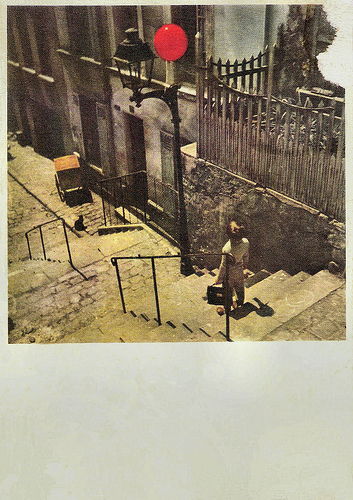
French postcard by F. Hazan Editeur, Paris, no. 1. Photo: Albert Lamorisse, 1956. Publicity still for Le ballon rouge/The red balloon (Albert Lamorisse, 1956). Caption: "Decouverte de ballon". (Discovery of the balloon).
Le ballon rouge
Pascal and Albert Lamorisse are best known for their next film, the beloved urban fairy tale Le ballon rouge/The Red Balloon (1956). Pascal plays a little boy who is followed around the streets of Paris by large red balloon, which seems to have a will of its own. The balloon colours the boy’s otherwise dreary, grey days. It follows him to school, to the bus, and to church. Boy and balloon play together in the streets of Paris and try to elude a gang of boys that wants to destroy the balloon.
Renaldo Matlin at IMDb : “The vivid colors and the wonderful use of Paris scenery is only part of the experience, another large part is the touching performance by the director's six year old son Pascal in the lead (how lucky he didn't fall and break his neck in that opening scene where he finds the balloon!). The look on his face in the final scene is every bit as heartbreaking as that of Jackie Coogan in Chaplin's legendary The Kid.”
Pascal’s sister, Sabine, portrays a little girl. Le Ballon Rouge is a short film of only 34 minutes, without dialogue. It is filmed for the most part in the Belleville area of Paris. It is now a colourful record of Belleville while the area had fallen into decay by the 1960s, prompting the Parisian government to demolish the area as a slum-clearance effort.
Albert Lamorisse took home another Grand Prix from the Cannes Film Festival but this time he also won an Academy Award for writing the best original screenplay in 1956. Throughout the 1960s, 1970s, 1980s and early 1990s Le Ballon Rouge was popular in elementary classrooms all over the world, but not in France.
db du monteil at IMDb : “Since its success in the festival de Cannes 1956, Albert Lamorisse's short film was relegated to purgatory. Often dismissed by French critics as bland, mushy and arty, it sank slowly but inexorably into oblivion. The other countries have always had a warm spot for it. And they are right. If you were a young student in the late fifties/early sixties, Le ballon rouge was one of your initiation books. After 1968, the story almost completely disappeared from textbooks. Actually it was new wave ‘avant l'heure’! Filmed in the streets of Paris - as Varda, Truffaut and countless others would do afterwards - its form was innovative.”
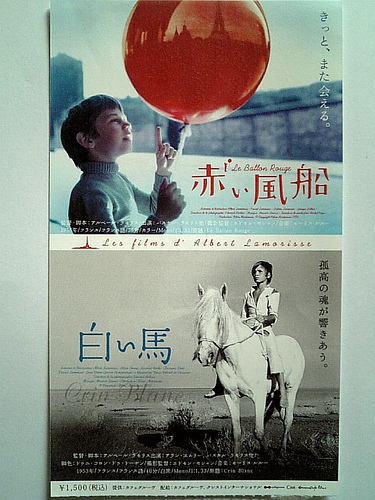
Japanese cinema ticket for Crin blanc: Le cheval sauvage/Wild Stallion (1953) and Le ballon rouge/The Red Balloon (1956). Source: ak.i. (Flickr).
Le voyage en ballon
Next, Pascal Lamorisse played a lead role in his father’s first feature film Le voyage en ballon/Stowaway in the Sky (1960). In this sequel to Le ballon rouge, Albert Lamorisse floats his public across the French country sides and town church steeples, brilliantly and colourfully photographed.
Hal Erickson at AllMovie : “Stowaway in the Sky is a disarmingly simple French-made children's story. The plot is implicit in the title: A small child, fascinated by a lighter-than-air balloon, clambers aboard. The balloon takes flight, lifting the child upward to an amazing adventure. The land-bound adults have conniptions as the balloon wafts by; the child has nothing more than a great time.”
The film was not a commercial success and it was Pascal Lamorisse’s last film. Albert Lamorisse retreated to documentary shorts. He was also the creator of the board game Risk. Originally, published in France in 1957, it was called La Conquête du monde. It was eventually picked up by Parker Brothers, and sold in the United States under the name Risk.
In 1970, the 48 years-old Albert Lamorisse was killed in a helicopter crash in Iran while shooting a documentary near Teheran. Pascal Lamorisse and his mother later edited the film from Albert’s production notes. The resulting film, Le vent des amoureux/The Lovers' Wind (1978) is a visually stunning helicopter tour of Iran. It was nominated for an Oscar as best feature documentary for the Academy Award ceremonies of 1979.
From then on Pascal Lamorisse disappeared in anonymity. In 2007, Hou Hsiao-Hsien directed Flight of the Red Balloon, a direct homage to Le ballon rouge and to father and son Lamorisse. That year Pascal Lamorisse did a short audio interview with NPR, where he talked about the re-release of Le ballon rouge/The Red Balloon and about his plans to do a sequel. This sequel hasn't happened yet.
Crin blanc: Le cheval sauvage/Wild Stallion (1953). Source: Emiliano Jelicié (YouTube).
Rerelease trailer for Le ballon rouge/The Red Balloon (1956). Source: MOVIECLIPS Classic Trailers (YouTube).
Sources: Hal Erickson (AllMovie), James Travers (Films de France), Dustin Rowles (Pajiba), db du monteil (IMDb), Renaldo Matlin (IMDb), Howard Schumann (IMDb), Wikipedia, and .

Italian postcard in the series Piccoli uomini nel cinema by Ed. Villaggio del Fanciullo, Bologna. Photo: Cino del Duca. Publicity still for Le ballon rouge/The red balloon (Albert Lamorisse, 1956).
Crin blanc
Pascal Lamorisse was born in 1950. He is the son of film director Albert Lamorisse, who began his career as a photographer, but turned to directing short films in the late 1940s. His first film was Bim (1951) about an Arab boy and his donkey. Remarkable is the poetic quality of this film and his later work always involving the fantasy world of children.
When Pascal was only three he made his film debut in his father’s second film Crin blanc: Le cheval sauvage/Wild Stallion (1953). He played the little brother of the lead figure, the fisher boy Folco (Alain Emery).
The story is situated in the Camargue, in the south of France where the river Rhone meets the Mediterranean Sea. Herds of wild horses roam the tidal marshes. Ranchers seek to capture a white stallion with along mane called Crin Blanc (White Mane), which is the leader of a group of wild horses. But Crin Blanc escapes capture time after time.
Folco witnesses the horse's furious fight for its freedom makes friends with the horse after the ranchers supposedly give him up to whomever can capture him. They change their minds when they see the boy has tamed Crin Blanc and take off after the horse again, with the boy on his back. Both boy and horse, fed up with the continual fight for freedom and peace, and the duplicity of men, head out to sea as the men plead with the boy to turn back.
The short 40-minute film was the winner of the Grand Prix for best short film at the Cannes Film Festival of 1953 and was nominated for the Best Documentary BAFTA Award in 1954.
Howard Schumann at IMDb calls it ‘A truly gorgeous film’: “The ending is dark, perhaps too dark for many children, demanding of them a complexity that they perhaps are incapable of at a tender age. Yet the film does not patronize, introducing the viewer to the notion that standing up for what is right regardless of the outcome is one of the most important things in life and does not depend on age or strength. The poetic narration, delivered by Jean-Pierre Grenier and co-written by the acclaimed author and film critic James Agee, adds an extra dimension of sensitivity to the film that the viewer, whether child or adult, can immediately respond to.“

French postcard by F. Hazan Editeur, Paris, no. 1. Photo: Albert Lamorisse, 1956. Publicity still for Le ballon rouge/The red balloon (Albert Lamorisse, 1956). Caption: "Decouverte de ballon". (Discovery of the balloon).
Le ballon rouge
Pascal and Albert Lamorisse are best known for their next film, the beloved urban fairy tale Le ballon rouge/The Red Balloon (1956). Pascal plays a little boy who is followed around the streets of Paris by large red balloon, which seems to have a will of its own. The balloon colours the boy’s otherwise dreary, grey days. It follows him to school, to the bus, and to church. Boy and balloon play together in the streets of Paris and try to elude a gang of boys that wants to destroy the balloon.
Renaldo Matlin at IMDb : “The vivid colors and the wonderful use of Paris scenery is only part of the experience, another large part is the touching performance by the director's six year old son Pascal in the lead (how lucky he didn't fall and break his neck in that opening scene where he finds the balloon!). The look on his face in the final scene is every bit as heartbreaking as that of Jackie Coogan in Chaplin's legendary The Kid.”
Pascal’s sister, Sabine, portrays a little girl. Le Ballon Rouge is a short film of only 34 minutes, without dialogue. It is filmed for the most part in the Belleville area of Paris. It is now a colourful record of Belleville while the area had fallen into decay by the 1960s, prompting the Parisian government to demolish the area as a slum-clearance effort.
Albert Lamorisse took home another Grand Prix from the Cannes Film Festival but this time he also won an Academy Award for writing the best original screenplay in 1956. Throughout the 1960s, 1970s, 1980s and early 1990s Le Ballon Rouge was popular in elementary classrooms all over the world, but not in France.
db du monteil at IMDb : “Since its success in the festival de Cannes 1956, Albert Lamorisse's short film was relegated to purgatory. Often dismissed by French critics as bland, mushy and arty, it sank slowly but inexorably into oblivion. The other countries have always had a warm spot for it. And they are right. If you were a young student in the late fifties/early sixties, Le ballon rouge was one of your initiation books. After 1968, the story almost completely disappeared from textbooks. Actually it was new wave ‘avant l'heure’! Filmed in the streets of Paris - as Varda, Truffaut and countless others would do afterwards - its form was innovative.”

Japanese cinema ticket for Crin blanc: Le cheval sauvage/Wild Stallion (1953) and Le ballon rouge/The Red Balloon (1956). Source: ak.i. (Flickr).
Le voyage en ballon
Next, Pascal Lamorisse played a lead role in his father’s first feature film Le voyage en ballon/Stowaway in the Sky (1960). In this sequel to Le ballon rouge, Albert Lamorisse floats his public across the French country sides and town church steeples, brilliantly and colourfully photographed.
Hal Erickson at AllMovie : “Stowaway in the Sky is a disarmingly simple French-made children's story. The plot is implicit in the title: A small child, fascinated by a lighter-than-air balloon, clambers aboard. The balloon takes flight, lifting the child upward to an amazing adventure. The land-bound adults have conniptions as the balloon wafts by; the child has nothing more than a great time.”
The film was not a commercial success and it was Pascal Lamorisse’s last film. Albert Lamorisse retreated to documentary shorts. He was also the creator of the board game Risk. Originally, published in France in 1957, it was called La Conquête du monde. It was eventually picked up by Parker Brothers, and sold in the United States under the name Risk.
In 1970, the 48 years-old Albert Lamorisse was killed in a helicopter crash in Iran while shooting a documentary near Teheran. Pascal Lamorisse and his mother later edited the film from Albert’s production notes. The resulting film, Le vent des amoureux/The Lovers' Wind (1978) is a visually stunning helicopter tour of Iran. It was nominated for an Oscar as best feature documentary for the Academy Award ceremonies of 1979.
From then on Pascal Lamorisse disappeared in anonymity. In 2007, Hou Hsiao-Hsien directed Flight of the Red Balloon, a direct homage to Le ballon rouge and to father and son Lamorisse. That year Pascal Lamorisse did a short audio interview with NPR, where he talked about the re-release of Le ballon rouge/The Red Balloon and about his plans to do a sequel. This sequel hasn't happened yet.
Crin blanc: Le cheval sauvage/Wild Stallion (1953). Source: Emiliano Jelicié (YouTube).
Rerelease trailer for Le ballon rouge/The Red Balloon (1956). Source: MOVIECLIPS Classic Trailers (YouTube).
Sources: Hal Erickson (AllMovie), James Travers (Films de France), Dustin Rowles (Pajiba), db du monteil (IMDb), Renaldo Matlin (IMDb), Howard Schumann (IMDb), Wikipedia, and .
Published on July 16, 2015 22:00
July 15, 2015
Gabriella Giorgelli
Beautiful Italian actress Gabriella Giorgelli (1941) appeared in more than 70 films since 1960. She is known for her supporting roles in masterpieces like Mario Monicelli’s I compagni (1963), and Federico Fellini’s La città delle donne (1980), but she also appeared in Spaghetti Westerns, Giallos and Sexploitation films.
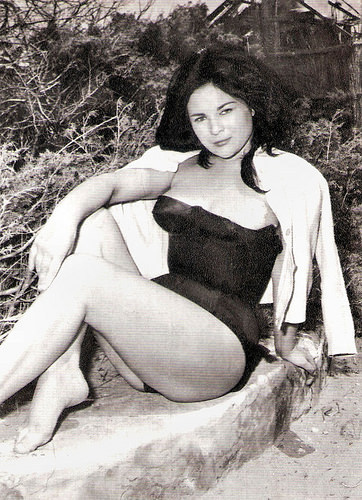
Italian collectors card by La Rotografica Romana. Edito dalla Nat Nuova Alta Tensione.
"She was only a whore!"
Gabriella Giorgelli was born in 1941 in Carrara, Tuscany, Italy. She worked as a secretary and typist, but she had other aspirations. In 1960, she made her film debut with a bit part in Tutti a casa/Everybody Go Home (Luigi Comencini, 1960), an international success.
She was attractive and had the willpower and ambition for an acting career and tried to grab the attention of film makers. In 1961 she was among the finalists for Miss Italia, a springboard for many Italian starlets.
The following year, she impressed as the prostitute Teresa in Damiano Damiani's L' Isola di Arturo/Arturo's Island (1962). In the same year she played a prostitute in in the first feature film directed by 21 years-old Bernardo Bertolucci, La commare secca (1962). It is a Rashomon like exploration of the murder of a prostitute, based on a story by Pier Paolo Pasolini.
Tom Wiener at AllMovie : “For a 21-year-old filmmaker, this is a remarkably pessimistic work; the film's opening image, of a sheaf of paper tossed from a car on highway overpass and eventually floating down to the corpse of the prostitute on the grass, to the murderer's cries as he's arrested -- "She was only a whore!" -- we get a sense that life, at least in some quarters of society, is easily disposable.”
The following year, she acted in I Compagni/The Organizer (Mario Monicelli, 1963) with Marcello Mastroianni as a labour activist who becomes involved with a group of textile factory workers in Turin at the end of the 19th century who go on strike. The script was nominated for Best Original Screenplay at the 37th Academy Awards.
Giorgelli also appeared in the comedy Frenesia dell’estate/Shivers in Summer (Luigi Zampa, 1963) starring Vittorio Gassman . She also appeared in a typical film genre of the era, the anthology film. An example was the French-Dutch-Italian-Japanese coproduction Les plus belles escroqueries du monde/The World's Most Beautiful Swindlers (1964), composed of five segments, each of which was created with a different set of writers, directors, and actors. The directors were Claude Chabrol, Jean-Luc Godard, Ugo Gregoretti, Hiromichi Horikawa and Roman Polanski. Giorgelli played a Neapolitan prostitute (again) in the Italian segment, directed by Gregoretti.
When film roles were few and far between, Gabriella Giorgelli also appeared in early versions of the fotoromanzi (the Italian fotonovelas in comic-book format, with photographs instead of illustrations, combined with small dialogue bubbles), such as in Sadistik.
Trailer La Commare Secca (1963). Source FilmGorillas.Com (Daily Motion).
Trailer I Compagni/The Organizer (1963). Source: The Criterion Collection (YouTube).
When Women Had Tails
Gabriella Giorgelli continued her career with roles in Spaghetti Westerns and erotic comedies. She played a saloon dancer in the Western Uno straniero a Sacramento/Stranger in Sacramento (Sergio Bergonzelli, 1965) starring bodybuilder Mickey Hargitay. In I lunghi giorni della vendetta/Long Days of Vengeance (Florestano Vancini, 1967), she played the female lead opposite Giuliano Gemma and Francisco Rabal . The film is a spaghetti western version of Alexandre Dumas' novel The Count of Monte Cristo.
Also based on a novel by Dumas was the historical drama Le calde notti di Lady Hamilton/Emma Hamilton (Christian-Jaque, 1968) which depicts the love affair between Emma Hamilton ( Michèle Mercier ) and Horatio Nelson (Richard Johnson). In these films she generally played supporting parts.
A commercial success was the Italian comedy Quando le Donne Avevano la Coda/When Women Had Tails (Pasquale Festa Campanile, 1970) starring Giuliano Gemma and Senta Berger . It was set in pre-historic times when ‘women had tails’ and were hunted by cavemen.
In France, she appeared in Le voyou/The Crook (Claude Lelouch, 1970) with Jean-Louis Trintignant as an incurable thief. Another box office success was the Western comedy La vita a volte è molto dura, vero Provvidenza?/Life Is Tough, Eh Providence? (Giulio Petroni, 1972) with Tomas Milian . Interesting is also the Giallo Sette orchidee macchiate di rosso/Seven Blood-Stained Orchids (Umberto Lenzi, 1972) with Rossella Falk and Uschi Glas . It was a coproduction with Germany, where it was presented 38th (and final) Edgar Wallace film from the post-war era.
Giorgelli played once more a prostitute in a Italian-French coproduction, the Giallo-Poliziottesco La polizia è al servizio del cittadino?/The Police Serve the Citizens? (Romolo Guerrieri, 1973) with Enrico Maria Salerno and John Steiner.
Probably the best of her later films was La città delle donne/City of Women (Federico Fellini, 1980). Amid Fellini's characteristic combination of dreamlike, outrageous, and artistic imagery, Marcello Mastroianni plays Snàporaz, a man who voyages through male and female spaces toward a confrontation with his own attitudes toward women and his wife. Giorgelli played the Fishwoman of San Leo.
She then again played with Tomas Milian in the poliziottesco-comedy Delitto sull'autostrada/Crime on the Highway (Bruno Corbucci, 1982). It is the ninth chapter in the Nico Giraldi film series starring Tomas Milian . She also had a part in the cult favourite Hercules (Luigi Cozzi, 1983) featuring Lou Ferrigno. It was followed by I Cinque del Condor - Squadra selvaggia (Umberto Lenzi, 1985) in which she played a psychic medium.
Excellent was Storia d'amore/A Tale of Love (Franco Maselli, 1986) in which she played the mother of Blas Roca-Rey’s character. In addition to her film work, she also appeared on television in films and mini-series. One of her later films was the horror film M.D.C. - Maschera di cera/Wax Mask (1997), produced and written by Dario Argento. Previously appointed to be directed by Lucio Fulci, it marked the directorial debut of the special effect artist Sergio Stivaletti.
Gabriella Giorgelli is still active. She can be seen in recent documentaries about actor Amedeo Nazzari and about the comic book Sadistik.
Gabriella Giorgelli in La belva (Mario Costa, 1970) with Klaus Kinski . Source: facciadangela (YouTube).
Trailer La città delle donne/City of Women (1980). Source: Eurekaentertainment (YouTube).
Sources: Tom Wiener (AllMovie), Wikipedia (German, Italian and English) and .

Italian collectors card by La Rotografica Romana. Edito dalla Nat Nuova Alta Tensione.
"She was only a whore!"
Gabriella Giorgelli was born in 1941 in Carrara, Tuscany, Italy. She worked as a secretary and typist, but she had other aspirations. In 1960, she made her film debut with a bit part in Tutti a casa/Everybody Go Home (Luigi Comencini, 1960), an international success.
She was attractive and had the willpower and ambition for an acting career and tried to grab the attention of film makers. In 1961 she was among the finalists for Miss Italia, a springboard for many Italian starlets.
The following year, she impressed as the prostitute Teresa in Damiano Damiani's L' Isola di Arturo/Arturo's Island (1962). In the same year she played a prostitute in in the first feature film directed by 21 years-old Bernardo Bertolucci, La commare secca (1962). It is a Rashomon like exploration of the murder of a prostitute, based on a story by Pier Paolo Pasolini.
Tom Wiener at AllMovie : “For a 21-year-old filmmaker, this is a remarkably pessimistic work; the film's opening image, of a sheaf of paper tossed from a car on highway overpass and eventually floating down to the corpse of the prostitute on the grass, to the murderer's cries as he's arrested -- "She was only a whore!" -- we get a sense that life, at least in some quarters of society, is easily disposable.”
The following year, she acted in I Compagni/The Organizer (Mario Monicelli, 1963) with Marcello Mastroianni as a labour activist who becomes involved with a group of textile factory workers in Turin at the end of the 19th century who go on strike. The script was nominated for Best Original Screenplay at the 37th Academy Awards.
Giorgelli also appeared in the comedy Frenesia dell’estate/Shivers in Summer (Luigi Zampa, 1963) starring Vittorio Gassman . She also appeared in a typical film genre of the era, the anthology film. An example was the French-Dutch-Italian-Japanese coproduction Les plus belles escroqueries du monde/The World's Most Beautiful Swindlers (1964), composed of five segments, each of which was created with a different set of writers, directors, and actors. The directors were Claude Chabrol, Jean-Luc Godard, Ugo Gregoretti, Hiromichi Horikawa and Roman Polanski. Giorgelli played a Neapolitan prostitute (again) in the Italian segment, directed by Gregoretti.
When film roles were few and far between, Gabriella Giorgelli also appeared in early versions of the fotoromanzi (the Italian fotonovelas in comic-book format, with photographs instead of illustrations, combined with small dialogue bubbles), such as in Sadistik.
Trailer La Commare Secca (1963). Source FilmGorillas.Com (Daily Motion).
Trailer I Compagni/The Organizer (1963). Source: The Criterion Collection (YouTube).
When Women Had Tails
Gabriella Giorgelli continued her career with roles in Spaghetti Westerns and erotic comedies. She played a saloon dancer in the Western Uno straniero a Sacramento/Stranger in Sacramento (Sergio Bergonzelli, 1965) starring bodybuilder Mickey Hargitay. In I lunghi giorni della vendetta/Long Days of Vengeance (Florestano Vancini, 1967), she played the female lead opposite Giuliano Gemma and Francisco Rabal . The film is a spaghetti western version of Alexandre Dumas' novel The Count of Monte Cristo.
Also based on a novel by Dumas was the historical drama Le calde notti di Lady Hamilton/Emma Hamilton (Christian-Jaque, 1968) which depicts the love affair between Emma Hamilton ( Michèle Mercier ) and Horatio Nelson (Richard Johnson). In these films she generally played supporting parts.
A commercial success was the Italian comedy Quando le Donne Avevano la Coda/When Women Had Tails (Pasquale Festa Campanile, 1970) starring Giuliano Gemma and Senta Berger . It was set in pre-historic times when ‘women had tails’ and were hunted by cavemen.
In France, she appeared in Le voyou/The Crook (Claude Lelouch, 1970) with Jean-Louis Trintignant as an incurable thief. Another box office success was the Western comedy La vita a volte è molto dura, vero Provvidenza?/Life Is Tough, Eh Providence? (Giulio Petroni, 1972) with Tomas Milian . Interesting is also the Giallo Sette orchidee macchiate di rosso/Seven Blood-Stained Orchids (Umberto Lenzi, 1972) with Rossella Falk and Uschi Glas . It was a coproduction with Germany, where it was presented 38th (and final) Edgar Wallace film from the post-war era.
Giorgelli played once more a prostitute in a Italian-French coproduction, the Giallo-Poliziottesco La polizia è al servizio del cittadino?/The Police Serve the Citizens? (Romolo Guerrieri, 1973) with Enrico Maria Salerno and John Steiner.
Probably the best of her later films was La città delle donne/City of Women (Federico Fellini, 1980). Amid Fellini's characteristic combination of dreamlike, outrageous, and artistic imagery, Marcello Mastroianni plays Snàporaz, a man who voyages through male and female spaces toward a confrontation with his own attitudes toward women and his wife. Giorgelli played the Fishwoman of San Leo.
She then again played with Tomas Milian in the poliziottesco-comedy Delitto sull'autostrada/Crime on the Highway (Bruno Corbucci, 1982). It is the ninth chapter in the Nico Giraldi film series starring Tomas Milian . She also had a part in the cult favourite Hercules (Luigi Cozzi, 1983) featuring Lou Ferrigno. It was followed by I Cinque del Condor - Squadra selvaggia (Umberto Lenzi, 1985) in which she played a psychic medium.
Excellent was Storia d'amore/A Tale of Love (Franco Maselli, 1986) in which she played the mother of Blas Roca-Rey’s character. In addition to her film work, she also appeared on television in films and mini-series. One of her later films was the horror film M.D.C. - Maschera di cera/Wax Mask (1997), produced and written by Dario Argento. Previously appointed to be directed by Lucio Fulci, it marked the directorial debut of the special effect artist Sergio Stivaletti.
Gabriella Giorgelli is still active. She can be seen in recent documentaries about actor Amedeo Nazzari and about the comic book Sadistik.
Gabriella Giorgelli in La belva (Mario Costa, 1970) with Klaus Kinski . Source: facciadangela (YouTube).
Trailer La città delle donne/City of Women (1980). Source: Eurekaentertainment (YouTube).
Sources: Tom Wiener (AllMovie), Wikipedia (German, Italian and English) and .
Published on July 15, 2015 22:00
July 14, 2015
Imported from the USA: Guy Madison
Handsome American leading man Guy Madison (1922-1996) appeared in 85 films, on radio, and television. In the 1940s, he started as a fresh-faced dreamboat. He became a hero to the Baby Boom generation as James Butler Hickock in the television series Adventures of Wild Bill Hickok (1951-1958). After the Hickok series ended, Madison became a star of the European cinema.
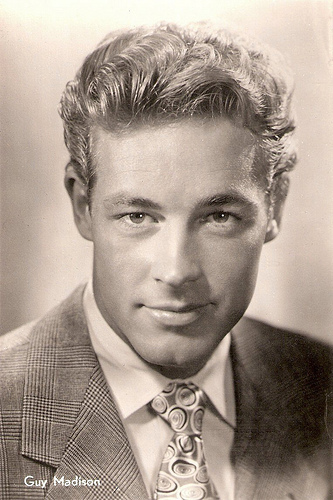
Dutch postcard.
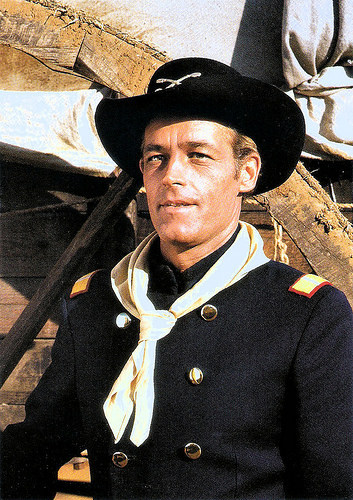
German postcard, no. 8 (1-56). Photo: CCC Produktion / Constantin. Publicity Still for Old Shatterhand (Hugo Fregonese, 1964). Caption: "Captain Bradley ist der Anführer eines Siedlertrecks, der nach Westen will." (Captain Bradley leads a group of settlers, who want to go west).
Major heartthrob material
Guy Madison was born in 1922 as Robert Ozell Moseley in Pumpkin Center, California, and was reared in nearby Bakersfield. His father was a machinist on the Santa Fe Railroad. His younger brother, Wayne Mallory, would later become a Western actor too.
As a young man Robert worked as a telephone lineman, but entered the Coast Guard at the beginning of the Second World War. While on liberty one weekend in Hollywood in 1944, he reportedly attended a Lux Radio Theatre broadcast and was spotted in the audience by Helen Ainsworth, an assistant to Henry Willson.
Willson was the talent agent for producer David O. Selznick at the time. Selznick wanted an unknown sailor to play a small but prominent part in the Home Front morale-booster Since You Went Away (John Cromwell, 1944), and promptly signed Robert Moseley to a contract. Selznick and Willson saw major heartthrob material in the blond, boyishly handsome sailor. They concocted the screen name Guy Madison (the 'guy' girls would like to meet, and Madison from a passing Dolly Madison cake wagon). Later, Willson would do the same for such other handsome film hunks as Rock Hudson (born Roy Scherer), Tab Hunter (Arthur Kelm), and Troy Donahue (Merle Johnson).
Madison filmed his three-minute bowling-alley sequence with Jennifer Jones and Robert Walker in Since You Went Away on a weekend pass and returned to duty. The film's release brought an avalanche of fan letters (43,000 pieces) for Madison's lonely, strikingly handsome young sailor, and at war's end he returned to find himself a star-in-the-making.
Madison was signed by RKO Pictures in 1946 and began appearing in romantic comedies and such dramas as Till the End of Time (Edward Dmytryk, 1946), starring Dorothy McGuire as a war widow, uncertain whether she should or could make a second start with Madison. Despite an initial woodenness to his acting, Madison grew as a performer, studying and working in theatre. However, his career seemed to evaporate by the end of the 1940s.
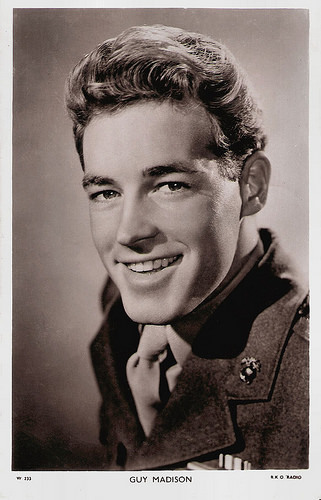
Italian postcard by Picturegoer, London, no. W. 233. Photo: R.K.O. Radio. Publicity still for Till the End of Time (Edward Dmytryk, 1946).
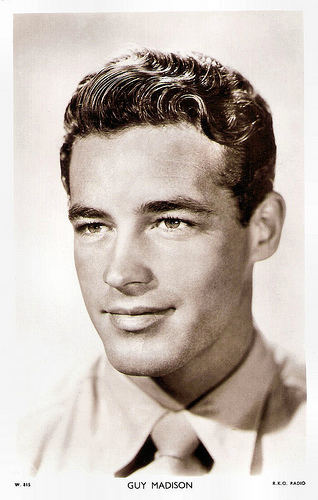
British postcard in the Picturegoer Series, London, no. W 815. Photo: R.K.O. Radio.
Numerous beefcake photographs
Guy Madison was the subject of numerous beefcake photographs while building a film persona.
He played leads in a series of programmers, such as the American Civil War film Drums in the Deep South (William Cameron Menzies, 1951), before being cast as legendary U.S. Marshal Wild Bill Hickok in Adventures of Wild Bill Hickok, with Andy Devine as the trusty and funny sidekick Jingles.
The show ran on television from 1951 to 1958 and on radio from 1951 to 1956. Adventures of Wild Bill Hickok made Guy Madison a household name and earned him a new crop of fans, especially among children. Soon, Madison's visage began appearing on cereal boxes, toys, and other promotional items. Sixteen feature films were released by Monogram Pictures between 1952 and 1955 that consisted of combined episodes of the series.
His popularity as Hickok led to a starring role in the 3-D film The Charge at Feather River (Gordon Douglas, 1953), whose success gave him a new lease on life in Hollywood. He was cast as a tight-lipped action hero in Westerns like The Command (David Butler, 1954) and The Last Frontier (Anthony Mann, 1955) with Victor Mature.
Madison was also the executive producer of the Western Reprisal! (George Sherman, 1956) in which he played a half Indian who poses as white.
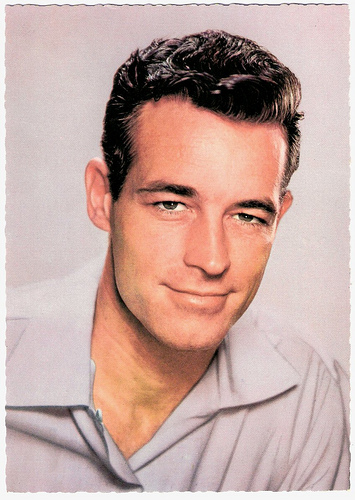
German postcard by ISV, no. A 46. Photo: 20th Century Fox.
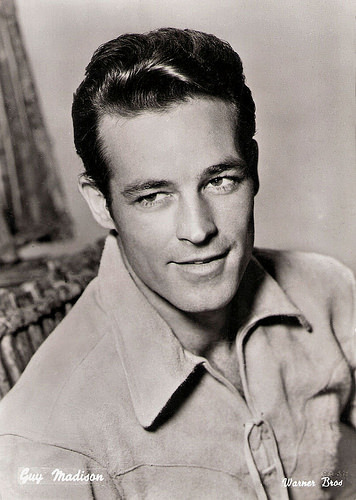
Italian postcard by Bromofoto, Milano, no. 684. Photo: Warner Bros.
Karl May
After the Hickok series ended, Guy Madison found work scarce in the USA and travelled to Europe. There he made around 90 films.
He first found work in Rome in Peplums like La Schiava di Roma/Slave of Rome (Sergio Grieco, Franco Prosperi, 1961) with Rosanna Podestà , and Rosmunda e Alboino (Carlo Campogalliani, 1961) opposite Jack Palance.
He became a popular star of the European cinema after successes as the Karl May Western Old Shatterhand/Apaches' Last Battle (Hugo Fregonese, 1964) opposite Lex Barker , and made a surprising number of popular Spaghetti Westerns in the mid to late 1960s. These included 7 winchester per un massacre/Payment in Blood (Enzo G. Castellari, 1967) with Edd Byrnes, and I lunghi giorni dell'odio/This Man Can't Die (Gianfranco Baldanello, 1968), with Rik Battaglia .
He left Italy in 1970 and temporarily settled in Texas, later returning to Los Angeles. In Hollywood, he appeared mainly in cameo roles, such as in Won Ton Ton, the Dog Who Saved Hollywood (Michael Winner, 1976). His last film appearance was in Red River (Richard Michaels, 1988) with James Arness and Ty Hardin. But this TV movie didn't compare with the 1948 classic by Howard Hawks on which it was based.
Later that year, Madison was in a serious auto accident that damaged his lungs. A variety of health problems limited his work in later years, and he died from emphysema in 1996. He was 74.
Guy Madison married his first wife, beautiful and haunted actress Gail Russell, in 1949. Russell's alcoholism helped bring an end to the marriage in 1954. From 1954 till 1964, he was married to model and actress Sheila Connolly, with whom he had four children, Bridget, Dolly, Erin and Robert. His best friend was actor Rory Calhoun who was later named 'godfather' to Madison's eldest daughter Bridget.
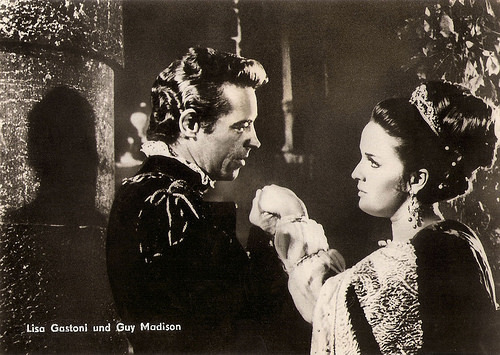
East-German postcard by VEB Progress Filmvertrieb, no. 258/69. Photo: publicity still for Il vendicatore mascherato/Gentlemen of the Night (Pino Mercanti, 1964).
Guy Madison in Since You Went Away (1944). Source: DoddiGS (YouTube).
Trailer Old Shatterhand/Apaches' Last Battle (1964). Source: cronosmantas (YouTube).
Sources: David Shipman (The Independent), William Grimes (The New York Times), Bridget Madison (Guy Madison Offical Site), (IMDb), Brian J. Walker (Brian's Drive-in Theater), Terry (Gay Influence), Wikipedia and .

Dutch postcard.

German postcard, no. 8 (1-56). Photo: CCC Produktion / Constantin. Publicity Still for Old Shatterhand (Hugo Fregonese, 1964). Caption: "Captain Bradley ist der Anführer eines Siedlertrecks, der nach Westen will." (Captain Bradley leads a group of settlers, who want to go west).
Major heartthrob material
Guy Madison was born in 1922 as Robert Ozell Moseley in Pumpkin Center, California, and was reared in nearby Bakersfield. His father was a machinist on the Santa Fe Railroad. His younger brother, Wayne Mallory, would later become a Western actor too.
As a young man Robert worked as a telephone lineman, but entered the Coast Guard at the beginning of the Second World War. While on liberty one weekend in Hollywood in 1944, he reportedly attended a Lux Radio Theatre broadcast and was spotted in the audience by Helen Ainsworth, an assistant to Henry Willson.
Willson was the talent agent for producer David O. Selznick at the time. Selznick wanted an unknown sailor to play a small but prominent part in the Home Front morale-booster Since You Went Away (John Cromwell, 1944), and promptly signed Robert Moseley to a contract. Selznick and Willson saw major heartthrob material in the blond, boyishly handsome sailor. They concocted the screen name Guy Madison (the 'guy' girls would like to meet, and Madison from a passing Dolly Madison cake wagon). Later, Willson would do the same for such other handsome film hunks as Rock Hudson (born Roy Scherer), Tab Hunter (Arthur Kelm), and Troy Donahue (Merle Johnson).
Madison filmed his three-minute bowling-alley sequence with Jennifer Jones and Robert Walker in Since You Went Away on a weekend pass and returned to duty. The film's release brought an avalanche of fan letters (43,000 pieces) for Madison's lonely, strikingly handsome young sailor, and at war's end he returned to find himself a star-in-the-making.
Madison was signed by RKO Pictures in 1946 and began appearing in romantic comedies and such dramas as Till the End of Time (Edward Dmytryk, 1946), starring Dorothy McGuire as a war widow, uncertain whether she should or could make a second start with Madison. Despite an initial woodenness to his acting, Madison grew as a performer, studying and working in theatre. However, his career seemed to evaporate by the end of the 1940s.

Italian postcard by Picturegoer, London, no. W. 233. Photo: R.K.O. Radio. Publicity still for Till the End of Time (Edward Dmytryk, 1946).

British postcard in the Picturegoer Series, London, no. W 815. Photo: R.K.O. Radio.
Numerous beefcake photographs
Guy Madison was the subject of numerous beefcake photographs while building a film persona.
He played leads in a series of programmers, such as the American Civil War film Drums in the Deep South (William Cameron Menzies, 1951), before being cast as legendary U.S. Marshal Wild Bill Hickok in Adventures of Wild Bill Hickok, with Andy Devine as the trusty and funny sidekick Jingles.
The show ran on television from 1951 to 1958 and on radio from 1951 to 1956. Adventures of Wild Bill Hickok made Guy Madison a household name and earned him a new crop of fans, especially among children. Soon, Madison's visage began appearing on cereal boxes, toys, and other promotional items. Sixteen feature films were released by Monogram Pictures between 1952 and 1955 that consisted of combined episodes of the series.
His popularity as Hickok led to a starring role in the 3-D film The Charge at Feather River (Gordon Douglas, 1953), whose success gave him a new lease on life in Hollywood. He was cast as a tight-lipped action hero in Westerns like The Command (David Butler, 1954) and The Last Frontier (Anthony Mann, 1955) with Victor Mature.
Madison was also the executive producer of the Western Reprisal! (George Sherman, 1956) in which he played a half Indian who poses as white.

German postcard by ISV, no. A 46. Photo: 20th Century Fox.

Italian postcard by Bromofoto, Milano, no. 684. Photo: Warner Bros.
Karl May
After the Hickok series ended, Guy Madison found work scarce in the USA and travelled to Europe. There he made around 90 films.
He first found work in Rome in Peplums like La Schiava di Roma/Slave of Rome (Sergio Grieco, Franco Prosperi, 1961) with Rosanna Podestà , and Rosmunda e Alboino (Carlo Campogalliani, 1961) opposite Jack Palance.
He became a popular star of the European cinema after successes as the Karl May Western Old Shatterhand/Apaches' Last Battle (Hugo Fregonese, 1964) opposite Lex Barker , and made a surprising number of popular Spaghetti Westerns in the mid to late 1960s. These included 7 winchester per un massacre/Payment in Blood (Enzo G. Castellari, 1967) with Edd Byrnes, and I lunghi giorni dell'odio/This Man Can't Die (Gianfranco Baldanello, 1968), with Rik Battaglia .
He left Italy in 1970 and temporarily settled in Texas, later returning to Los Angeles. In Hollywood, he appeared mainly in cameo roles, such as in Won Ton Ton, the Dog Who Saved Hollywood (Michael Winner, 1976). His last film appearance was in Red River (Richard Michaels, 1988) with James Arness and Ty Hardin. But this TV movie didn't compare with the 1948 classic by Howard Hawks on which it was based.
Later that year, Madison was in a serious auto accident that damaged his lungs. A variety of health problems limited his work in later years, and he died from emphysema in 1996. He was 74.
Guy Madison married his first wife, beautiful and haunted actress Gail Russell, in 1949. Russell's alcoholism helped bring an end to the marriage in 1954. From 1954 till 1964, he was married to model and actress Sheila Connolly, with whom he had four children, Bridget, Dolly, Erin and Robert. His best friend was actor Rory Calhoun who was later named 'godfather' to Madison's eldest daughter Bridget.

East-German postcard by VEB Progress Filmvertrieb, no. 258/69. Photo: publicity still for Il vendicatore mascherato/Gentlemen of the Night (Pino Mercanti, 1964).
Guy Madison in Since You Went Away (1944). Source: DoddiGS (YouTube).
Trailer Old Shatterhand/Apaches' Last Battle (1964). Source: cronosmantas (YouTube).
Sources: David Shipman (The Independent), William Grimes (The New York Times), Bridget Madison (Guy Madison Offical Site), (IMDb), Brian J. Walker (Brian's Drive-in Theater), Terry (Gay Influence), Wikipedia and .
Published on July 14, 2015 22:00
July 13, 2015
Ludwig Trautmann
German film actor Ludwig Trautmann (1885-1957) was the first German film star. Between 1912 and 1955, he appeared in 69 films, and also wrote, produced and directed several films. In the Nazi period he was prosecuted because of homosexual acts.
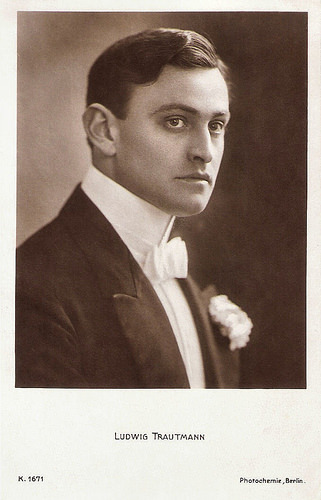
German postcard by Photochemie, Berlin, no. K. 1671.
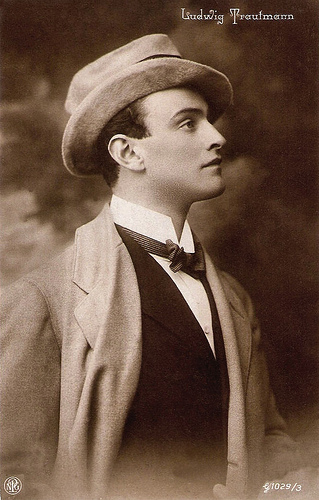
German postcard by PNG, no. G 1029/3.
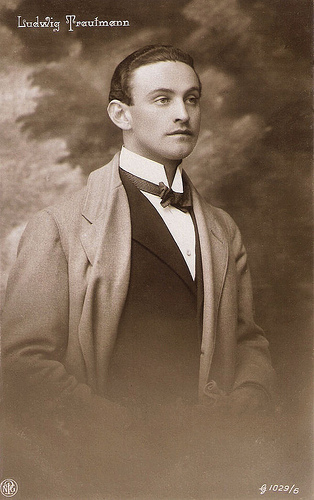
German postcard by NPG (Neue Photographische Gesellschaft), no. 1029/6.
A Castle with 22 Rooms
Ludwig Trautmann was born in Dachsbach, Germany, in 1885. He learned for salesman but in 1901 he made his stage debut. He later worked for theatres in Bochum, Konstanz und Hermannstadt. A cinema owner in Baden-Baden introduced him to film.
In 1912 he signed a contract with the Bioskop-Filmgesellschaft (Bioskop Film Studio). It was the first film contact ever signed in Germany. Trautmann appeared in such short silent films as Madeleine (Emil Albes, 1912) and Die schwarze Natter/The Black Adder (Franz Hofer, 1913).
He soon became known as detective Brown in short silent films directed by Harry Piel , starting with Der Triumph des Todes/The Triumph of Death (Harry Piel, 1912) and Schatten der Nacht/Shadows of the Night (Harry Piel, 1913).
In Austria he played a priest in Der Pfarrer von Kirchfeld/The Priest from Kirchfeld (Jacob Fleck, Luise Fleck, 1914) starring Max Neufeld. He appeared opposite Henny Porten in Gretchen Wendland (Curt A. Stark, 1914), Das Ende vom Liede/The End of the Song (Rudolf Biebrach, 1915) and Die Ehe der Luise Rohrbach/The Marriage of Luise Rohrbach (Rudolf Biebrach, 1917), also with Emil Jannings.
In 1916 he appeared opposite the other superstar of the silent German cinema, Asta Nielsen in Dora Brandes (Magnus Stifter, 1916) and Das Liebes-ABC/The ABC of Love (Magnus Stifter, 1916).
Ludwig Trautmann had become a very successful film actor. He was the darling of the women and on the height of his career he bought a castle with 22 rooms for the in those days outrageous sum of DM 480.000.--.
He was in a position to found his own film company, and during World War I, he directed, produced and wrote several films. Among these films are Das Geheimnis der Villa Dox/The Secret of Villa Dox (Ludwig Trautmann, 1916) and Filmelend: Das Glashausmädchen/Film Misery – The Glass House Girl (Ludwig Trautmann, 1919).
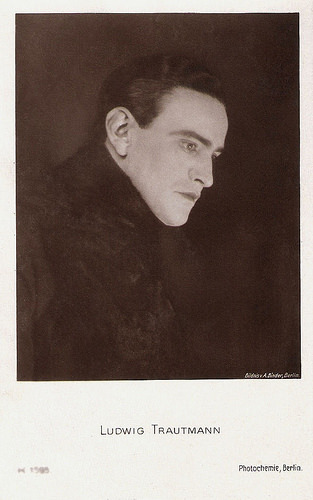
German postcard by Photochemie, Berlin, no. K. 1595. Photo: Alex Binder, Berlin.
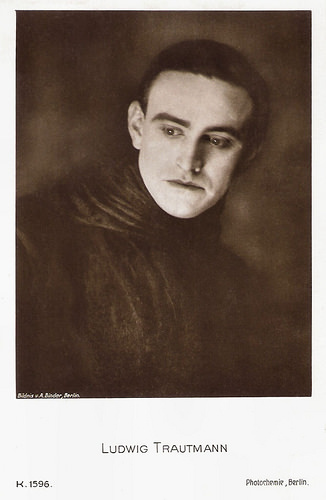
German postcard by Photochemie, Berlin, no. K. 1596. Photo: Alex Binder, Berlin.
Imprisoned For Homosexual Acts
Ludwig Trautmann worked in the early 1920s with director Siegfried Dessauer on such films as Frauen…/Women… (Siegfried Dessauer, 1920) and Die goldene Mauer/The Golden Wall (Siegfried Dessauer, 1921) with Mabel May-Yong .
He had a small part in the epic Marie Antoinette - Das Leben einer Königin/Marie Antoinette, the Life of a Queen (Rudolf Meinert, 1922) starring Italian diva Diana Karenne and filmed on location in Paris, but the film offers became scarce.
Between 1925 and 1932 Trautmann did not appear in the cinema, but then he reappeared in supporting roles in films like Die elf Schill'schen Offiziere/The eleven Officers of Major Von Schill (Rudolf Meinert, 1932) with Hertha Thiele , and Trenck - Der Roman einer großen Liebe (Ernst Neubach, Heinz Paul, 1932) starring Hans Stüwe .
He also appeared in the Ufa production Ein Mann will nach Deutschland/A Man Wants to Get to Germany (Paul Wegener, 1934) with Karl Ludwig Diehl and had a bit part in Ein idealer Gatte/An Ideal Husband (Herbert Selpin, 1935) based on the famous play by Oscar Wilde.
Between July and October 1935 Trautmann was imprisoned for homosexual acts. (Homosexual acts between males were a crime at the time in Germany and many other countries. Trautmann was imprisoned because of paragraph 175, a notorious provision of the German Criminal Code dating from 1871. The Nazis broadened the law in 1935; in the prosecutions that followed, thousands died in concentration camps. Between 1871 and 1994 around 140,000 men were convicted under the law).
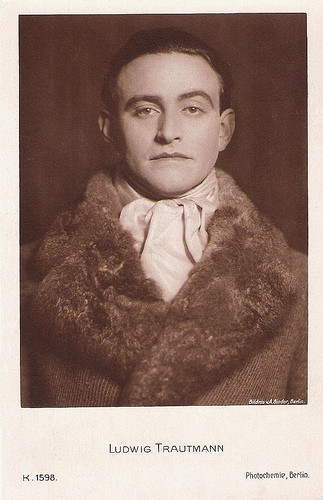
German postcard by Photochemie, no. K 1587. Photo: Alex Binder, Berlin.
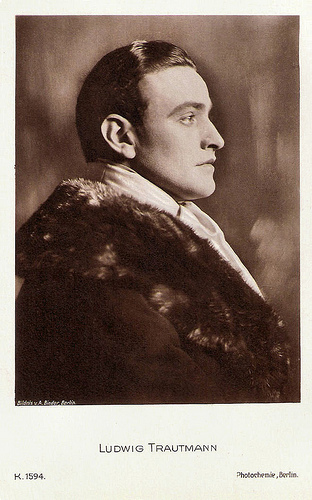
German postcard by Photochemie, no. K.1594. Photo: Alex Binder, Berlin.
A Cheerful Trip in the Past
After he was released from prison, Ludwig Trautmann was banned from the Reichstheaterkammer and the Reichsfilmkammer, so it was impossible for him to work as an actor in Nazi-Germany anymore. He left for France, but in 1939 he returned to Germany. In 1940 he was again imprisoned for six months because of his homosexuality.
After the war Ludwig Trautmann worked for the Volksbühne Berlin. He produced the documentary Eine Fröhliche Fahrt in die Vergangenheit/A cheerful trip in the past (1949). In 1951 he was a member of the jury at the 1st Berlin International Film Festival.
He also played a few more film roles. He had bit parts in the comedies Postlagernd Turteltaube/Poste Restante Turtledove (Gerhard T. Buchholz, 1952), and in Briefträger Müller/Mailman Mueller (Hohn Reinhardt, 1953) starring Heinz Rühmann .
His last film was the DEFA production Robert Mayer - der Arzt aus Heilbronn/Robert Mayer, the Doctor from Heilbronn (Helmut Spiess, 1955).
In 1957 and after a long illness, Ludwig Trautmann died in a Berlin hospital. He was 71.
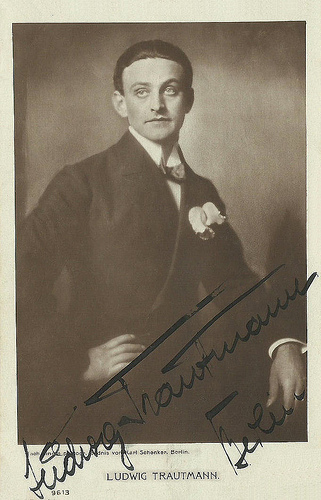
German postcard, no. 9613. Photo: Karl Schenker, Berlin. Collection: Didier Hanson.
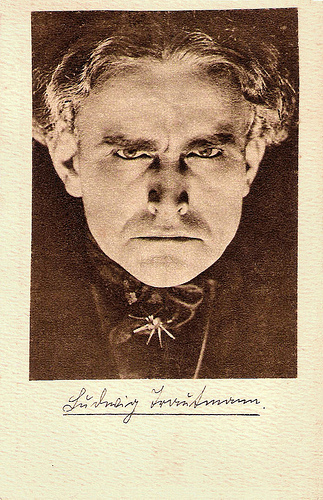
Vintage postcard by FUPRA.
Sources: Thomas Staedeli (Cyranos), Filmportal.de, Wikipedia (English and German), and .

German postcard by Photochemie, Berlin, no. K. 1671.

German postcard by PNG, no. G 1029/3.

German postcard by NPG (Neue Photographische Gesellschaft), no. 1029/6.
A Castle with 22 Rooms
Ludwig Trautmann was born in Dachsbach, Germany, in 1885. He learned for salesman but in 1901 he made his stage debut. He later worked for theatres in Bochum, Konstanz und Hermannstadt. A cinema owner in Baden-Baden introduced him to film.
In 1912 he signed a contract with the Bioskop-Filmgesellschaft (Bioskop Film Studio). It was the first film contact ever signed in Germany. Trautmann appeared in such short silent films as Madeleine (Emil Albes, 1912) and Die schwarze Natter/The Black Adder (Franz Hofer, 1913).
He soon became known as detective Brown in short silent films directed by Harry Piel , starting with Der Triumph des Todes/The Triumph of Death (Harry Piel, 1912) and Schatten der Nacht/Shadows of the Night (Harry Piel, 1913).
In Austria he played a priest in Der Pfarrer von Kirchfeld/The Priest from Kirchfeld (Jacob Fleck, Luise Fleck, 1914) starring Max Neufeld. He appeared opposite Henny Porten in Gretchen Wendland (Curt A. Stark, 1914), Das Ende vom Liede/The End of the Song (Rudolf Biebrach, 1915) and Die Ehe der Luise Rohrbach/The Marriage of Luise Rohrbach (Rudolf Biebrach, 1917), also with Emil Jannings.
In 1916 he appeared opposite the other superstar of the silent German cinema, Asta Nielsen in Dora Brandes (Magnus Stifter, 1916) and Das Liebes-ABC/The ABC of Love (Magnus Stifter, 1916).
Ludwig Trautmann had become a very successful film actor. He was the darling of the women and on the height of his career he bought a castle with 22 rooms for the in those days outrageous sum of DM 480.000.--.
He was in a position to found his own film company, and during World War I, he directed, produced and wrote several films. Among these films are Das Geheimnis der Villa Dox/The Secret of Villa Dox (Ludwig Trautmann, 1916) and Filmelend: Das Glashausmädchen/Film Misery – The Glass House Girl (Ludwig Trautmann, 1919).

German postcard by Photochemie, Berlin, no. K. 1595. Photo: Alex Binder, Berlin.

German postcard by Photochemie, Berlin, no. K. 1596. Photo: Alex Binder, Berlin.
Imprisoned For Homosexual Acts
Ludwig Trautmann worked in the early 1920s with director Siegfried Dessauer on such films as Frauen…/Women… (Siegfried Dessauer, 1920) and Die goldene Mauer/The Golden Wall (Siegfried Dessauer, 1921) with Mabel May-Yong .
He had a small part in the epic Marie Antoinette - Das Leben einer Königin/Marie Antoinette, the Life of a Queen (Rudolf Meinert, 1922) starring Italian diva Diana Karenne and filmed on location in Paris, but the film offers became scarce.
Between 1925 and 1932 Trautmann did not appear in the cinema, but then he reappeared in supporting roles in films like Die elf Schill'schen Offiziere/The eleven Officers of Major Von Schill (Rudolf Meinert, 1932) with Hertha Thiele , and Trenck - Der Roman einer großen Liebe (Ernst Neubach, Heinz Paul, 1932) starring Hans Stüwe .
He also appeared in the Ufa production Ein Mann will nach Deutschland/A Man Wants to Get to Germany (Paul Wegener, 1934) with Karl Ludwig Diehl and had a bit part in Ein idealer Gatte/An Ideal Husband (Herbert Selpin, 1935) based on the famous play by Oscar Wilde.
Between July and October 1935 Trautmann was imprisoned for homosexual acts. (Homosexual acts between males were a crime at the time in Germany and many other countries. Trautmann was imprisoned because of paragraph 175, a notorious provision of the German Criminal Code dating from 1871. The Nazis broadened the law in 1935; in the prosecutions that followed, thousands died in concentration camps. Between 1871 and 1994 around 140,000 men were convicted under the law).

German postcard by Photochemie, no. K 1587. Photo: Alex Binder, Berlin.

German postcard by Photochemie, no. K.1594. Photo: Alex Binder, Berlin.
A Cheerful Trip in the Past
After he was released from prison, Ludwig Trautmann was banned from the Reichstheaterkammer and the Reichsfilmkammer, so it was impossible for him to work as an actor in Nazi-Germany anymore. He left for France, but in 1939 he returned to Germany. In 1940 he was again imprisoned for six months because of his homosexuality.
After the war Ludwig Trautmann worked for the Volksbühne Berlin. He produced the documentary Eine Fröhliche Fahrt in die Vergangenheit/A cheerful trip in the past (1949). In 1951 he was a member of the jury at the 1st Berlin International Film Festival.
He also played a few more film roles. He had bit parts in the comedies Postlagernd Turteltaube/Poste Restante Turtledove (Gerhard T. Buchholz, 1952), and in Briefträger Müller/Mailman Mueller (Hohn Reinhardt, 1953) starring Heinz Rühmann .
His last film was the DEFA production Robert Mayer - der Arzt aus Heilbronn/Robert Mayer, the Doctor from Heilbronn (Helmut Spiess, 1955).
In 1957 and after a long illness, Ludwig Trautmann died in a Berlin hospital. He was 71.

German postcard, no. 9613. Photo: Karl Schenker, Berlin. Collection: Didier Hanson.

Vintage postcard by FUPRA.
Sources: Thomas Staedeli (Cyranos), Filmportal.de, Wikipedia (English and German), and .
Published on July 13, 2015 22:00
July 12, 2015
Melina Mercouri
Melina Mercouri (1920-1994), was a vivacious, free-spirited Greek actress, singer and politician. She met international success in the films Pote Tin Kyriaki/Never on Sunday (1960), Phaedra (1962), Topkapi (1964), and Promesse de l'aube/Promise at Dawn (1970), all directed by her husband Jules Dassin.
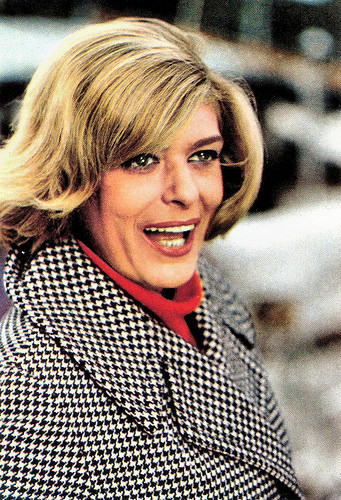
Italian postcard. Photo: Dear Film. Publicity still for 10:30 P.M. Summer (Jules Dassin, 1966).
A free-spirited prostitute
Melina Mercouri (Greek: Μελίνα Μερκούρη) was born as Maria Amalia Mercouri in 1920. Her father was former cavalry officer and member of parliament, Stamatis Mercouris, and her mother Eirini Lappa. Her Grandfather had been Mayor of Athens.
When Melina completed her secondary education, she attended the National Theatre's Drama School, much against the desires of her parents. After her graduation in 1944, Mercouri joined the National Theatre of Greece and played the role of Electra in Eugene O'Neill's play Mourning Becomes Electra in 1945.
In 1949, she had her first major stage success playing Blanche DuBois in A Streetcar Named Desire, written by Tennessee Williams and staged by Karolos Koun's Art Theatre. Until 1950, she also worked in the same theatre in plays by Aldous Huxley, Arthur Miller and André Roussin.
She then moved to Paris, where she appeared in boulevard plays by Jacques Deval and Marcel Achard, and met famous French playwrights and novelists such as Jean Cocteau, Jean-Paul Sartre, Colette and Françoise Sagan. In 1953, she received the Marika Kotopouli Prize and returned to Greece two years later. At the Kotopouli-Rex Theatre, Mercouri starred in plays like Macbeth by William Shakespeare and L'Alouette by Jean Anouilh. Her first husband was a wealthy landowner Panos Harokopos. They had married in 1941 and divorced in 1962.
She made her film debut as a young, wild woman who doesn't want to compromise and settle down in Stella (Michael Cacoyannis, 1955). The film sparked great controversy, and although it was initially rejected by Greek critics, it is now considered one of the five greatest Greek films. Stella received special praise at the 1956 Cannes Film Festival, where Mercouri met American film director Jules Dassin, who would become her husband in 1966, her mentor, and director.
Their first professional pairing was Celui qui doit mourir/He Who Must Die (Jules Dassin, 1957), based on the novel Christ Recrucified by Nikos Kazantzakis, and starring Jean Servais and Carl Möhner . The film is set in a Turkish-occupied Greek village shortly after World War I. The villagers put on a Passion Play, with ordinary people taking the roles of Jesus, Peter, Judas, etc. Staging the play leads to them rebelling against their Turkish rulers in a way that mirrors Jesus's story. Other films by Dassin and featuring Mercouri followed, such as La Legge/The Law (Jules Dassin, 1959) with Gina Lollobrigida .
Mercouri became well-known to international audiences when she starred in the romantic comedy Pote Tin Kyriaki/Ποτέ Την Κυριακή/Never on Sunday (Jules Dassin, 1960), in which Dassin was the director and co-star. The film tells the story of Ilya, a self-employed, free-spirited prostitute who lives in the port of Piraeus in Greece, and Homer, an American tourist from Middletown, Connecticut — a classical scholar enamoured with all things Greek. Homer feels Ilya's life style typifies the degradation of Greek classical culture and attempts to steer her onto the path of morality, while at the same time Ilya loosens the uptight Homer up. As Ilya, Mercouri earned the Best Actress Award at the 1960 Cannes Film Festival and was nominated for the Academy Award for Best Actress and the BAFTA Award for Best Actress in a Leading Role.

Spanish postcard by Productos Compactos, S.A., no. B 3768, 1991.
Minister for Culture
Melina Mercouri went on to star opposite Anthony Perkins in Phaedra (Jules Dassin, 1962), a modern adaption of Euripides' classic tragedy Hippolytus. For her part she was nominated again for the BAFTA Award and the Golden Globe Award for Best Actress in Motion Picture Drama.
The recognition of her acting talent did not stop and her role in the heist film Topkapi (Jules Dassin, 1964) granted her one more nomination, this time for the Golden Globe Award for Best Actress in Motion Picture Musical or Comedy.
She worked with other noted directors such as Vittorio De Sica at the Commedia all'italiana Il giudizio universale/The Last Judgement (1961), Carl Foreman at the Anglo-American war film The Victors (1963), and Juan Antonio Bardem at Los pianos mecánicos/The Uninhibited (1965) with James Mason and Hardy Krüger .
She continued her stage career in the Greek production of Tennessee Williams' Sweet Bird of Youth (1960), under the direction of Karolos Koun. In 1967, she played on Broadway the leading role in Illya Darling, a musical version of her film Pote tin Kyriaki/Never on Sunday (1960). For this part she was nominated for the Tony Award for Best Performance by a Leading Actress in a Musical, while her performance in the film La Promesse de l'aube/Promise at Dawn (Jules Dassin, 1970) earned her another Golden Globe Award nomination.
Mercouri concentrated on her stage career for the following years, playing in the Greek productions of The Threepenny Opera and, for a second time, Sweet Bird of Youth, in addition to the ancient Greek tragedies Medea and Oresteia.
She retired from film acting in 1978, when she played in her last film, Kravgi gynaikon/Κραυγή Γυναικών/A Dream of Passion (Jules Dassin, 1978). The story follows Mercouri as Maya, an actress playing Medea, who seeks out Brenda Collins, (Ellen Burstyn), a woman who is in jail for murdering her own children to punish her husband for his infidelity.
Mercouri’s last performance on stage was in the opera Pylades at the Athens Concert Hall in 1992, portraying Clytemnestra.
When Greece was overtaken by a military junta in 1966, Mercouri ardently protested this affront to the world's oldest democracy. As a result, her citizenship was revoked, and from 1967 through 1974 she was denied re-entry into her native country. During these seven years of her exile in France, Mercouri recorded some highly popular records, Melina Mercouri, L oeillet rouge, si Melina m etait contee, Je suis Grecque, including famous Greek and French songs.
In 1977, she became a member of the Hellenic Parliament and in 1981 the first female Minister for Culture of Greece. Mercouri was the person who, in 1983, conceived and proposed the program of the European Capital of Culture, which has been established by the European Union since 1985. She was a strong advocate for the return to Athens of the Elgin marbles, the marbles which were removed from the Parthenon, and are now displayed in the British Museum. She served as Greece's Minister of Culture from 1981 to 1990. In 1990, she ran for mayor of Athens, but was defeated.
In 1994, Melina Mercouri died from lung cancer at the Memorial Sloan Kettering Cancer Center in New York City, at the age of 73. She was the step-mother of three children by Jules Dassin, including the French singer Joe Dassin.
Trailer for Pote Tin Kyriaki/Ποτέ Την Κυριακή/Never on Sunday (1960). Source: Withlotsabutta (YouTube).
Trailer for Phaedra (1962). Source: Fejedelem1986 (YouTube).
Sources: Hal Erickson (AllMovie), Wikipedia, and .

Italian postcard. Photo: Dear Film. Publicity still for 10:30 P.M. Summer (Jules Dassin, 1966).
A free-spirited prostitute
Melina Mercouri (Greek: Μελίνα Μερκούρη) was born as Maria Amalia Mercouri in 1920. Her father was former cavalry officer and member of parliament, Stamatis Mercouris, and her mother Eirini Lappa. Her Grandfather had been Mayor of Athens.
When Melina completed her secondary education, she attended the National Theatre's Drama School, much against the desires of her parents. After her graduation in 1944, Mercouri joined the National Theatre of Greece and played the role of Electra in Eugene O'Neill's play Mourning Becomes Electra in 1945.
In 1949, she had her first major stage success playing Blanche DuBois in A Streetcar Named Desire, written by Tennessee Williams and staged by Karolos Koun's Art Theatre. Until 1950, she also worked in the same theatre in plays by Aldous Huxley, Arthur Miller and André Roussin.
She then moved to Paris, where she appeared in boulevard plays by Jacques Deval and Marcel Achard, and met famous French playwrights and novelists such as Jean Cocteau, Jean-Paul Sartre, Colette and Françoise Sagan. In 1953, she received the Marika Kotopouli Prize and returned to Greece two years later. At the Kotopouli-Rex Theatre, Mercouri starred in plays like Macbeth by William Shakespeare and L'Alouette by Jean Anouilh. Her first husband was a wealthy landowner Panos Harokopos. They had married in 1941 and divorced in 1962.
She made her film debut as a young, wild woman who doesn't want to compromise and settle down in Stella (Michael Cacoyannis, 1955). The film sparked great controversy, and although it was initially rejected by Greek critics, it is now considered one of the five greatest Greek films. Stella received special praise at the 1956 Cannes Film Festival, where Mercouri met American film director Jules Dassin, who would become her husband in 1966, her mentor, and director.
Their first professional pairing was Celui qui doit mourir/He Who Must Die (Jules Dassin, 1957), based on the novel Christ Recrucified by Nikos Kazantzakis, and starring Jean Servais and Carl Möhner . The film is set in a Turkish-occupied Greek village shortly after World War I. The villagers put on a Passion Play, with ordinary people taking the roles of Jesus, Peter, Judas, etc. Staging the play leads to them rebelling against their Turkish rulers in a way that mirrors Jesus's story. Other films by Dassin and featuring Mercouri followed, such as La Legge/The Law (Jules Dassin, 1959) with Gina Lollobrigida .
Mercouri became well-known to international audiences when she starred in the romantic comedy Pote Tin Kyriaki/Ποτέ Την Κυριακή/Never on Sunday (Jules Dassin, 1960), in which Dassin was the director and co-star. The film tells the story of Ilya, a self-employed, free-spirited prostitute who lives in the port of Piraeus in Greece, and Homer, an American tourist from Middletown, Connecticut — a classical scholar enamoured with all things Greek. Homer feels Ilya's life style typifies the degradation of Greek classical culture and attempts to steer her onto the path of morality, while at the same time Ilya loosens the uptight Homer up. As Ilya, Mercouri earned the Best Actress Award at the 1960 Cannes Film Festival and was nominated for the Academy Award for Best Actress and the BAFTA Award for Best Actress in a Leading Role.

Spanish postcard by Productos Compactos, S.A., no. B 3768, 1991.
Minister for Culture
Melina Mercouri went on to star opposite Anthony Perkins in Phaedra (Jules Dassin, 1962), a modern adaption of Euripides' classic tragedy Hippolytus. For her part she was nominated again for the BAFTA Award and the Golden Globe Award for Best Actress in Motion Picture Drama.
The recognition of her acting talent did not stop and her role in the heist film Topkapi (Jules Dassin, 1964) granted her one more nomination, this time for the Golden Globe Award for Best Actress in Motion Picture Musical or Comedy.
She worked with other noted directors such as Vittorio De Sica at the Commedia all'italiana Il giudizio universale/The Last Judgement (1961), Carl Foreman at the Anglo-American war film The Victors (1963), and Juan Antonio Bardem at Los pianos mecánicos/The Uninhibited (1965) with James Mason and Hardy Krüger .
She continued her stage career in the Greek production of Tennessee Williams' Sweet Bird of Youth (1960), under the direction of Karolos Koun. In 1967, she played on Broadway the leading role in Illya Darling, a musical version of her film Pote tin Kyriaki/Never on Sunday (1960). For this part she was nominated for the Tony Award for Best Performance by a Leading Actress in a Musical, while her performance in the film La Promesse de l'aube/Promise at Dawn (Jules Dassin, 1970) earned her another Golden Globe Award nomination.
Mercouri concentrated on her stage career for the following years, playing in the Greek productions of The Threepenny Opera and, for a second time, Sweet Bird of Youth, in addition to the ancient Greek tragedies Medea and Oresteia.
She retired from film acting in 1978, when she played in her last film, Kravgi gynaikon/Κραυγή Γυναικών/A Dream of Passion (Jules Dassin, 1978). The story follows Mercouri as Maya, an actress playing Medea, who seeks out Brenda Collins, (Ellen Burstyn), a woman who is in jail for murdering her own children to punish her husband for his infidelity.
Mercouri’s last performance on stage was in the opera Pylades at the Athens Concert Hall in 1992, portraying Clytemnestra.
When Greece was overtaken by a military junta in 1966, Mercouri ardently protested this affront to the world's oldest democracy. As a result, her citizenship was revoked, and from 1967 through 1974 she was denied re-entry into her native country. During these seven years of her exile in France, Mercouri recorded some highly popular records, Melina Mercouri, L oeillet rouge, si Melina m etait contee, Je suis Grecque, including famous Greek and French songs.
In 1977, she became a member of the Hellenic Parliament and in 1981 the first female Minister for Culture of Greece. Mercouri was the person who, in 1983, conceived and proposed the program of the European Capital of Culture, which has been established by the European Union since 1985. She was a strong advocate for the return to Athens of the Elgin marbles, the marbles which were removed from the Parthenon, and are now displayed in the British Museum. She served as Greece's Minister of Culture from 1981 to 1990. In 1990, she ran for mayor of Athens, but was defeated.
In 1994, Melina Mercouri died from lung cancer at the Memorial Sloan Kettering Cancer Center in New York City, at the age of 73. She was the step-mother of three children by Jules Dassin, including the French singer Joe Dassin.
Trailer for Pote Tin Kyriaki/Ποτέ Την Κυριακή/Never on Sunday (1960). Source: Withlotsabutta (YouTube).
Trailer for Phaedra (1962). Source: Fejedelem1986 (YouTube).
Sources: Hal Erickson (AllMovie), Wikipedia, and .
Published on July 12, 2015 22:00
July 11, 2015
Luisa Garella
Italian actress Luisa Garella (1913-?) was a supporting actress of the Italian cinema of the late 1930s and early 1940s. After the war she disappeared.
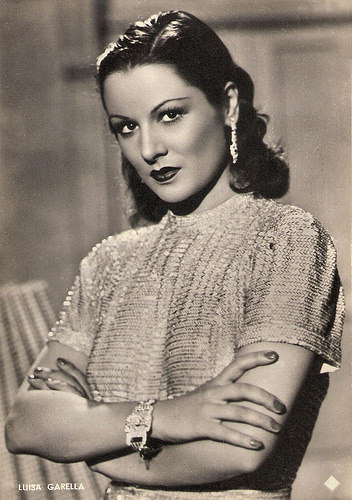
Italian postcard by Aser, no. 151. Photo: Luxardo Scia Film.
Getting stuck in the sand
Luisa Garella was born as Luisa Gargarella in Firenze (Florence) in 1913 (according to Les gens du Cinema ; Wikipedia and IMDb mention 1921 as her birth year).
She made her film debut in a minor role in Paraninfo/The Matchmaker (Amleto Palermi, 1934). In 1936 she played the girlfriend of George Rigaud in the French-Italian drama L'esclave blanc/Black Jungle (Jean-Paul Paulin, 1936).
DB DuMonteil at IMDb : “'L'Esclave Blanc' was recently brought out of oblivion, thanks to a DVD release, with English subtitles. First intended for Carl Theodore Dreyer, who used to talk about the white man, ‘getting stuck in the sand’ in a country which was not his. Jean-Paul Paulin's work is very obscure, even for French viewers: when he replaced Dreyer, he had already made three movies, two of which are still screened on TV: ‘La Femme Nue’ and the rather funny comedy ‘l'Abbé Constantin’. He called it a day in 1950, 26 years before he died. To write that ‘L'Esclave Blanc’ is a colonialist movie is to state the obvious: the last pictures show a peaceful land, under the white man's watchful eye.”

Italian postcard.
The Woman in black
The following year, Luisa Garella played Hedwig in the comedy L'uomo che sorride/The man who smiles (Mario Mattioli, 1937) opposite Vittorio De Sica and Assia Noris .
In 1941 she played Franca in a version of the comedy Scampolo (Nunzio Malasomma, 1941) with Amedeo Nazzari and Lilia Silvi in the title role. Another film in which she played a supporting role was the thriller Grattacieli/Skyscrapers (Guglielmo Giannini, 1943) in the role of Helga Manners. Again under the direction of Giannini, she played Carla Rossiter in 4 ragazze sognano/4 girls dream (Guglielmo Giannini, 1943) co-starring with Vanna Vanni and Valentina Cortese .
That same year, she also appeared in the film La signora in nero/The Woman in black (Nunzio Malasomma, 1943), in the role of Rosetta May. Because of the war, the film was released somewhat haphazardly. It was briefly shown in December 1943 in Rome, but most of the Italian public had to wait until 1945 to see it. It eventually went on general release in June 1946.
After this brief film career, Luisa Garella seems to have abandoned the cinema. There is very little information about her later years. Considering her age Italian Wikipedia presumes that she has deceased. IMDb however mentions one post-war credit: a small part in an American TV series, Conrad Nagel Theater (1955). So maybe Luisa Garella emigrated to the US.
Sources: Les gens du Cinema (French), Wikipedia (Italian), and .

Italian postcard by Aser, no. 151. Photo: Luxardo Scia Film.
Getting stuck in the sand
Luisa Garella was born as Luisa Gargarella in Firenze (Florence) in 1913 (according to Les gens du Cinema ; Wikipedia and IMDb mention 1921 as her birth year).
She made her film debut in a minor role in Paraninfo/The Matchmaker (Amleto Palermi, 1934). In 1936 she played the girlfriend of George Rigaud in the French-Italian drama L'esclave blanc/Black Jungle (Jean-Paul Paulin, 1936).
DB DuMonteil at IMDb : “'L'Esclave Blanc' was recently brought out of oblivion, thanks to a DVD release, with English subtitles. First intended for Carl Theodore Dreyer, who used to talk about the white man, ‘getting stuck in the sand’ in a country which was not his. Jean-Paul Paulin's work is very obscure, even for French viewers: when he replaced Dreyer, he had already made three movies, two of which are still screened on TV: ‘La Femme Nue’ and the rather funny comedy ‘l'Abbé Constantin’. He called it a day in 1950, 26 years before he died. To write that ‘L'Esclave Blanc’ is a colonialist movie is to state the obvious: the last pictures show a peaceful land, under the white man's watchful eye.”

Italian postcard.
The Woman in black
The following year, Luisa Garella played Hedwig in the comedy L'uomo che sorride/The man who smiles (Mario Mattioli, 1937) opposite Vittorio De Sica and Assia Noris .
In 1941 she played Franca in a version of the comedy Scampolo (Nunzio Malasomma, 1941) with Amedeo Nazzari and Lilia Silvi in the title role. Another film in which she played a supporting role was the thriller Grattacieli/Skyscrapers (Guglielmo Giannini, 1943) in the role of Helga Manners. Again under the direction of Giannini, she played Carla Rossiter in 4 ragazze sognano/4 girls dream (Guglielmo Giannini, 1943) co-starring with Vanna Vanni and Valentina Cortese .
That same year, she also appeared in the film La signora in nero/The Woman in black (Nunzio Malasomma, 1943), in the role of Rosetta May. Because of the war, the film was released somewhat haphazardly. It was briefly shown in December 1943 in Rome, but most of the Italian public had to wait until 1945 to see it. It eventually went on general release in June 1946.
After this brief film career, Luisa Garella seems to have abandoned the cinema. There is very little information about her later years. Considering her age Italian Wikipedia presumes that she has deceased. IMDb however mentions one post-war credit: a small part in an American TV series, Conrad Nagel Theater (1955). So maybe Luisa Garella emigrated to the US.
Sources: Les gens du Cinema (French), Wikipedia (Italian), and .
Published on July 11, 2015 23:29
July 10, 2015
Buffalo Bill, l'eroe del Far West (1965)
An early example of the Spaghetti Western is Buffalo Bill, l'eroe del far west/Buffalo Bill, Hero of the Far West (Mario Costa, 1964). It was the Western debut of Gordon Scott, former Tarzan and hero of several Peplums. The muscular American starred as the legendary frontier scout and showman of the title. The film was a co-production of Italy, France and West Germany, which explains perhaps why the collectors cards in this post are German.
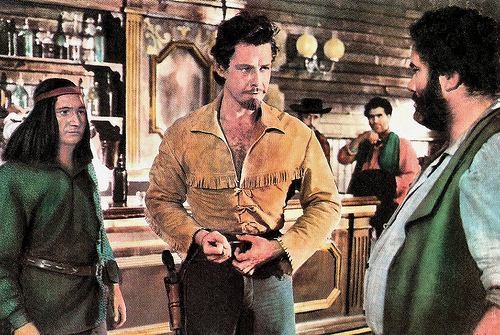
German collectors card by J & M Serienbilder Produktion Saar, no. 35. Photo: Gloria Film. Publicity still for Buffalo Bill, l'eroe del far west/Buffalo Bill, Hero of the Far West (Mario Costa, 1965) with Gordon Douglas. Caption: "Buffalo Bill, der Held des Wilden Westens ohne Furcht und Tadel, fürchtete selbst die gefährlichtsen Gegner nicht. Er ist entschlossen den illegalen Waffenhändlern das Handwerk zu legen." (Buffalo Bill, the hero of the Wild West without fear and without reproach, did not fear even the most dangerous opponent. He is determined to put down the business of the illegal arms dealers.)
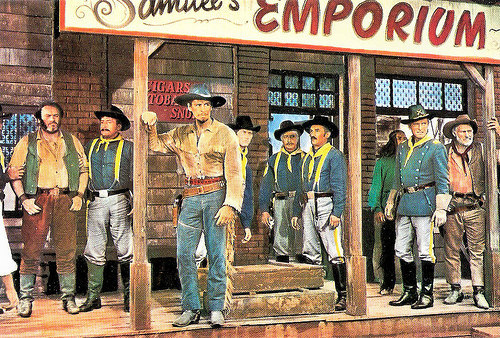
German collectors card by J & M Serienbilder Produktion Saar, no. 46. Photo: Gloria Film. Publicity still for Buffalo Bill, l'eroe del far west/Buffalo Bill, Hero of the Far West (Mario Costa, 1965). Caption: "Der erste Schurke, Big Sam, ist gefasst. Buffalo Bill hat bei ihm die Schiesseisen für die Rothäute gefunden. Big Sam gehört zu den Banditen, auf deren Konto die neunen Kämpfe zwischen Sioux und Weissen kommen." (The first villain, Big Sam is taken. Buffalo Bill has found at his place the firearms for the Redskins. Big Sam is one of the bandits, on whose account comes the new fighting between Sioux and whites.)
Buffalo Bill's Wild West
Buffalo Bill, l'eroe del Far West (1965) was not only the first Western of Gordon Scott, but also of veteran director Mario Costa. Costa, who had directed Scott in the Peplum Il gladiatore di Roma/Gladiator of Rome (1962), took the name of John Fordson. But the son of John Ford, the Italian was not exactly. Buffalo Bill would turn out to be his only Western.
There have been countless films and TV-films about Buffalo Bill, including Buffalo Bill (William A. Wellman, 1944) featuring Joel McCrea, Pony Express (Jerry Hopper, 1953) with Charlton Heston, and Buffalo Bill and the Indians, or Sitting Bull's History Lesson (Robert Altman, 1976) starring Paul Newman.
The real Buffalo Bill was William Frederick Cody (1846-1917), an American scout, bison hunter, and showman. During the American Civil War, he served for the Union from 1863 to the end of the war in 1865. Later he served as a civilian scout to the US Army during the Indian Wars, receiving the Medal of Honor in 1872. One of the most colorful figures of the American Old West, Buffalo Bill started performing in shows that displayed cowboy themes and episodes from the frontier and Indian Wars. He founded his Buffalo Bill's Wild West in 1883, taking his large company on tours.
Buffalo Bill’s Wild West toured Europe eight times, the first four tours between 1887 and 1892, and the last four from 1902 to 1906. In 1890 Cody met Pope Leo XIII, and that year, a competition took place in Italy. Buffalo Bill had met some of the Italian 'butteri' (Italian cowboys) and said his men were more skilled at roping calves and performing other similar actions. A group of Buffalo Bill's men challenged nine butteri, led by Augusto Imperiali in Rome. The Italian butteri easily won the competition and Augusto Imperiali became a sort of local hero after the event.
In the film Colonel William Cody, alias Buffalo Bill (Gordon Scott), intends to put an end to the dishonest relations between a gang of white swindlers and the Indian, Yellow Hand (Mirko Ellis). So he goes to the chief of Yellow Hand's tribe, White Fox (Feodor Chaliapin Jr.), and tries to convince him to sign a peace treaty with the Federal troops. In order to avoid this, the gun runners abduct White Fox's daughter, Silver Moon Ray (Catherine Ribeiro), attempting to put the blame on the soldiers of Colonel Peterson (Roldano Lupi).
The big showdown at the end of the film takes place in a cavalry fort with the Indians scaling the walls and gives Buffalo Bill a run for his money. It was all spectacularly filmed by Massimo Dallamano, who also was the cinematographer for Per un pugno di dollari/A Fistful of Dollars (Sergio Leone, 1964).
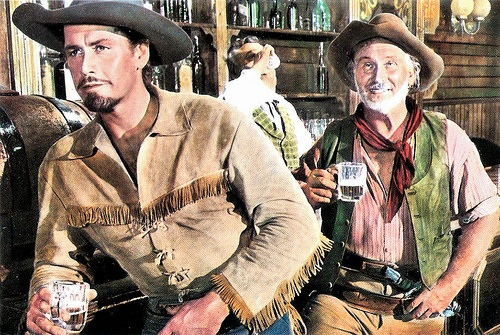
German collectors card by J & M Serienbilder Produktion Saar, no. 48. Photo: Gloria Film. Publicity still for Buffalo Bill, l'eroe del far west/Buffalo Bill, Hero of the Far West (Mario Costa, 1965). Caption: "Buffalo Bill kennt keinen Pardon für Bösewichte. Viele Gefahren haben den gerechten Indianerfreund hart gemacht. Das schwerste Abenteur steht den edlen Kämpfer noch bevor." (Buffalo Bill knows no mercy for the bad guys. Many threats have made the fair Indians friend hard. His hardest adventure is still to come for the noble fighter.)
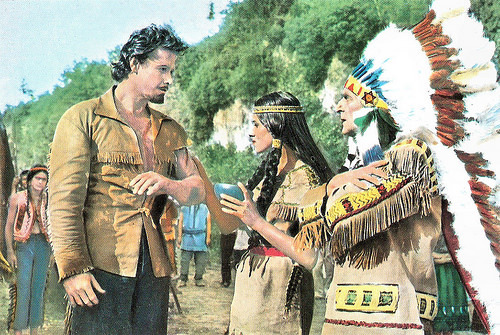
German collectors card by J & M Serienbilder Produktion Saar, no. 49. Photo: Gloria Film. Publicity still for Buffalo Bill, l'eroe del far west/Buffalo Bill, Hero of the Far West (Mario Costa, 1965) with Gordon Scott, Catherine Ribeiro and Feodor Chaliapin Jr. Caption: "Auch die schöne Tochter 'Mondstrahl' des Häuptlings 'Weisser Fuchs' ist Buffalo Bill, dem berühmten tapferen Mann der Weissen, zugetan. Sie versorgt seine Verwundung aus dem Kampf gegen den Sioux 'Gelbe Hand'." (The beautiful daughter 'Moonbeam' of chief 'White Fox' is devoted to Buffalo Bill, the famous brave man of the white. She cares for his wounds from the fight against the Sioux 'Yellow Hand'.)
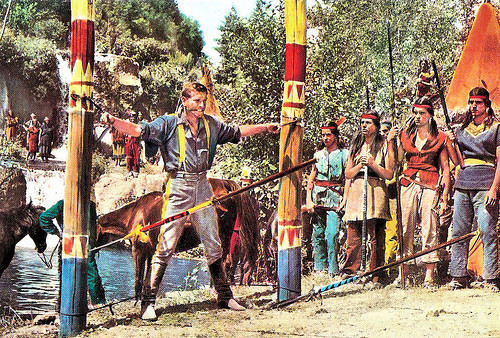
German collectors card by J & M Serienbilder Produktion Saar, no. 55. Photo: Gloria Film. Publicity still for Buffalo Bill, l'eroe del far west/Buffalo Bill, Hero of the Far West (Mario Costa, 1965). Caption: "Captain Hunter zerrt verzweifelt an den Fesseln. Der mutige Freund Buffalo Bills muss zusehen, wie im Lager der skalpgierigen Sioux-Krieger die Tochter seines Colonels gemartert werden soll." (Captain Hunter drags desperately at the chains. The courageous friend of Buffalo Bill must watch how the daughter of his colonel will be martyred in the camp of the scalp greedy Sioux Warriors.)
Adorable old-fashioned
Although I called Buffalo Bill, l'eroe del Far West/Buffalo Bill, Hero Of The West in the lead of this post a Spaghetti Western, it isn't quite like what you usually associate with this genre. Most of the pre-Sergio Leone Westerns made in Italy resemble conventional Hollywood horse operas. Reviewer Wizard-8 at IMDb : "The movie plays out like it was made by American filmmakers, from the standard western plot right down to the musical score."
The basic premise of Buffalo Bill, l'eroe del Far West also seems to be inspired by the Karl May films, like Der Schatz im Silbersee/Treasure of Silver Lake (Harald Reinl, 1963) and Winnetou - 1. Teil/Apache Gold (Harald Reinl, 1963), that precipitated the Spaghetti Western boom.
Another reviewer at IMDb , Steve Nyland, is positive about the casting of Gordon Scott as Buffalo Bill Cody: "Gordon Scott is well cast & appropriately larger than life as the Indian fighter turned US Army scout Buffalo Bill Cody, trading in his Samson tunic for a buckskin jacket + goatee. (...). And he plays Cody pretty much as he played the Son of Hercules: Strapping, brawny, beefy, but surprisingly intelligent, insightful, and considerate of even the guy whom he beats the stuffing out of in a bar room brawl. He is almost insufferably good, working for the native Indians to live side by side with his fellow Palefaces and keep the two sides from massacring each other."
Scott as Buffalo Bill is not working for himself to obtain vast sums of money like the bounty hunters in later Spaghetti Westerns. Instead, he is on a mission of mercy authorized by the President to root out injustice.
Steve Nyland: "The spaghetti genre itself had also changed by the time this film was circulating, with the more stylish approaches of DJANGO and Sergio Leone's 'Dollar' films making the more traditionalist approach seen here look a bit old fashioned by comparison. And that's exactly why I adore it: Here's a spaghetti western from the infancy of the genre when they were still making movies about good guys & bad guys, Injuns and the cavalry, and a do-gooder hero designed to be rooted for like he was Audie Murphy or something. The change of pace is quite refreshing."
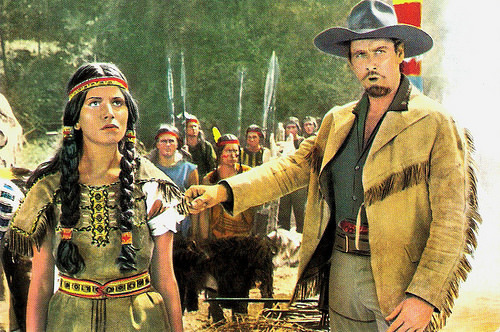
German collectors card by J & M Serienbilder Produktion Saar, no. 59. Photo: Gloria Film. Publicity still for Buffalo Bill, l'eroe del far west/Buffalo Bill, Hero of the Far West (Mario Costa, 1965). Caption: "Der erfolglose Angriff des Häuptlings 'Gelbe Hand' aus Fort Adam galt auch der Tochter des grossen Indianenführers 'Weiser Fuchs'. Ihre Verletzung stammt aus einem erbitterten Nahkampf, in den Buffalo Bill tollkühn eingegriffen hat." (The unsuccessful attack of the chief 'Yellow Hand' from Fort Adam applied also the daughter of the great Indian leader 'White Fox'. Her injury is from a fierce close combat, in which Buffalo Bill has intervened foolhardy.)
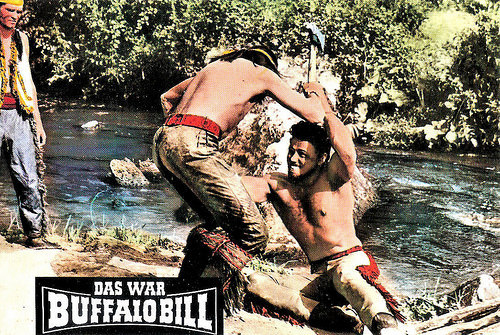
German collectors card by J & M Serienbilder Produktion Saar, no. 67. Photo: Gloria Film. Publicity still for Buffalo Bill, l'eroe del far west/Buffalo Bill, Hero of the Far West (Mario Costa, 1965) with Mirko Ellis and Gordon Scott (at right). Caption: "Wieder beweist der feige Häuptling Gelbe Hand'' im atemberaubenden Zweikampf mit Buffalo Bill seine Heimtücke. Er schmettert den Tomahawk auf den waffenlosen Gegner und deshalb verachten ihn jetzt sogar die eigenen Stammesgenossen." (Again the cowardly chief Yellow Hand hows his maliciousness in a breathtaking duel with Buffalo Bill. He smashes the Tomahawk on his unarmed opponent and therefore even his own tribesmen now despise him.)

German collectors card by J & M Serienbilder Produktion Saar, no. 68. Photo: Gloria Film. Publicity still for Buffalo Bill, l'eroe del far west/Buffalo Bill, Hero of the Far West (Mario Costa, 1965). Caption: "In einem Zweikampf auf Leben und Tod hat Buffalo Bill, der berühmteste Held des Wilden Westens, seinen gefährlichsten Feind bezwungen. Der edle Kämpfer schenkt seinem Gegner das Leben. Die Indianer selbst sollen seine Strafe bestimmen." (In a duel to death, Buffalo Bill, the famous hero of the Wild West, has defeated his most dangerous enemy. The noble warrior gives his opponent his life. The Indians themselves have to determine his punishment.)
Sources: Steve Nyland (IMDb), Wikipedia, IMDb and The Spaghetti Western Database.

German collectors card by J & M Serienbilder Produktion Saar, no. 35. Photo: Gloria Film. Publicity still for Buffalo Bill, l'eroe del far west/Buffalo Bill, Hero of the Far West (Mario Costa, 1965) with Gordon Douglas. Caption: "Buffalo Bill, der Held des Wilden Westens ohne Furcht und Tadel, fürchtete selbst die gefährlichtsen Gegner nicht. Er ist entschlossen den illegalen Waffenhändlern das Handwerk zu legen." (Buffalo Bill, the hero of the Wild West without fear and without reproach, did not fear even the most dangerous opponent. He is determined to put down the business of the illegal arms dealers.)

German collectors card by J & M Serienbilder Produktion Saar, no. 46. Photo: Gloria Film. Publicity still for Buffalo Bill, l'eroe del far west/Buffalo Bill, Hero of the Far West (Mario Costa, 1965). Caption: "Der erste Schurke, Big Sam, ist gefasst. Buffalo Bill hat bei ihm die Schiesseisen für die Rothäute gefunden. Big Sam gehört zu den Banditen, auf deren Konto die neunen Kämpfe zwischen Sioux und Weissen kommen." (The first villain, Big Sam is taken. Buffalo Bill has found at his place the firearms for the Redskins. Big Sam is one of the bandits, on whose account comes the new fighting between Sioux and whites.)
Buffalo Bill's Wild West
Buffalo Bill, l'eroe del Far West (1965) was not only the first Western of Gordon Scott, but also of veteran director Mario Costa. Costa, who had directed Scott in the Peplum Il gladiatore di Roma/Gladiator of Rome (1962), took the name of John Fordson. But the son of John Ford, the Italian was not exactly. Buffalo Bill would turn out to be his only Western.
There have been countless films and TV-films about Buffalo Bill, including Buffalo Bill (William A. Wellman, 1944) featuring Joel McCrea, Pony Express (Jerry Hopper, 1953) with Charlton Heston, and Buffalo Bill and the Indians, or Sitting Bull's History Lesson (Robert Altman, 1976) starring Paul Newman.
The real Buffalo Bill was William Frederick Cody (1846-1917), an American scout, bison hunter, and showman. During the American Civil War, he served for the Union from 1863 to the end of the war in 1865. Later he served as a civilian scout to the US Army during the Indian Wars, receiving the Medal of Honor in 1872. One of the most colorful figures of the American Old West, Buffalo Bill started performing in shows that displayed cowboy themes and episodes from the frontier and Indian Wars. He founded his Buffalo Bill's Wild West in 1883, taking his large company on tours.
Buffalo Bill’s Wild West toured Europe eight times, the first four tours between 1887 and 1892, and the last four from 1902 to 1906. In 1890 Cody met Pope Leo XIII, and that year, a competition took place in Italy. Buffalo Bill had met some of the Italian 'butteri' (Italian cowboys) and said his men were more skilled at roping calves and performing other similar actions. A group of Buffalo Bill's men challenged nine butteri, led by Augusto Imperiali in Rome. The Italian butteri easily won the competition and Augusto Imperiali became a sort of local hero after the event.
In the film Colonel William Cody, alias Buffalo Bill (Gordon Scott), intends to put an end to the dishonest relations between a gang of white swindlers and the Indian, Yellow Hand (Mirko Ellis). So he goes to the chief of Yellow Hand's tribe, White Fox (Feodor Chaliapin Jr.), and tries to convince him to sign a peace treaty with the Federal troops. In order to avoid this, the gun runners abduct White Fox's daughter, Silver Moon Ray (Catherine Ribeiro), attempting to put the blame on the soldiers of Colonel Peterson (Roldano Lupi).
The big showdown at the end of the film takes place in a cavalry fort with the Indians scaling the walls and gives Buffalo Bill a run for his money. It was all spectacularly filmed by Massimo Dallamano, who also was the cinematographer for Per un pugno di dollari/A Fistful of Dollars (Sergio Leone, 1964).

German collectors card by J & M Serienbilder Produktion Saar, no. 48. Photo: Gloria Film. Publicity still for Buffalo Bill, l'eroe del far west/Buffalo Bill, Hero of the Far West (Mario Costa, 1965). Caption: "Buffalo Bill kennt keinen Pardon für Bösewichte. Viele Gefahren haben den gerechten Indianerfreund hart gemacht. Das schwerste Abenteur steht den edlen Kämpfer noch bevor." (Buffalo Bill knows no mercy for the bad guys. Many threats have made the fair Indians friend hard. His hardest adventure is still to come for the noble fighter.)

German collectors card by J & M Serienbilder Produktion Saar, no. 49. Photo: Gloria Film. Publicity still for Buffalo Bill, l'eroe del far west/Buffalo Bill, Hero of the Far West (Mario Costa, 1965) with Gordon Scott, Catherine Ribeiro and Feodor Chaliapin Jr. Caption: "Auch die schöne Tochter 'Mondstrahl' des Häuptlings 'Weisser Fuchs' ist Buffalo Bill, dem berühmten tapferen Mann der Weissen, zugetan. Sie versorgt seine Verwundung aus dem Kampf gegen den Sioux 'Gelbe Hand'." (The beautiful daughter 'Moonbeam' of chief 'White Fox' is devoted to Buffalo Bill, the famous brave man of the white. She cares for his wounds from the fight against the Sioux 'Yellow Hand'.)

German collectors card by J & M Serienbilder Produktion Saar, no. 55. Photo: Gloria Film. Publicity still for Buffalo Bill, l'eroe del far west/Buffalo Bill, Hero of the Far West (Mario Costa, 1965). Caption: "Captain Hunter zerrt verzweifelt an den Fesseln. Der mutige Freund Buffalo Bills muss zusehen, wie im Lager der skalpgierigen Sioux-Krieger die Tochter seines Colonels gemartert werden soll." (Captain Hunter drags desperately at the chains. The courageous friend of Buffalo Bill must watch how the daughter of his colonel will be martyred in the camp of the scalp greedy Sioux Warriors.)
Adorable old-fashioned
Although I called Buffalo Bill, l'eroe del Far West/Buffalo Bill, Hero Of The West in the lead of this post a Spaghetti Western, it isn't quite like what you usually associate with this genre. Most of the pre-Sergio Leone Westerns made in Italy resemble conventional Hollywood horse operas. Reviewer Wizard-8 at IMDb : "The movie plays out like it was made by American filmmakers, from the standard western plot right down to the musical score."
The basic premise of Buffalo Bill, l'eroe del Far West also seems to be inspired by the Karl May films, like Der Schatz im Silbersee/Treasure of Silver Lake (Harald Reinl, 1963) and Winnetou - 1. Teil/Apache Gold (Harald Reinl, 1963), that precipitated the Spaghetti Western boom.
Another reviewer at IMDb , Steve Nyland, is positive about the casting of Gordon Scott as Buffalo Bill Cody: "Gordon Scott is well cast & appropriately larger than life as the Indian fighter turned US Army scout Buffalo Bill Cody, trading in his Samson tunic for a buckskin jacket + goatee. (...). And he plays Cody pretty much as he played the Son of Hercules: Strapping, brawny, beefy, but surprisingly intelligent, insightful, and considerate of even the guy whom he beats the stuffing out of in a bar room brawl. He is almost insufferably good, working for the native Indians to live side by side with his fellow Palefaces and keep the two sides from massacring each other."
Scott as Buffalo Bill is not working for himself to obtain vast sums of money like the bounty hunters in later Spaghetti Westerns. Instead, he is on a mission of mercy authorized by the President to root out injustice.
Steve Nyland: "The spaghetti genre itself had also changed by the time this film was circulating, with the more stylish approaches of DJANGO and Sergio Leone's 'Dollar' films making the more traditionalist approach seen here look a bit old fashioned by comparison. And that's exactly why I adore it: Here's a spaghetti western from the infancy of the genre when they were still making movies about good guys & bad guys, Injuns and the cavalry, and a do-gooder hero designed to be rooted for like he was Audie Murphy or something. The change of pace is quite refreshing."

German collectors card by J & M Serienbilder Produktion Saar, no. 59. Photo: Gloria Film. Publicity still for Buffalo Bill, l'eroe del far west/Buffalo Bill, Hero of the Far West (Mario Costa, 1965). Caption: "Der erfolglose Angriff des Häuptlings 'Gelbe Hand' aus Fort Adam galt auch der Tochter des grossen Indianenführers 'Weiser Fuchs'. Ihre Verletzung stammt aus einem erbitterten Nahkampf, in den Buffalo Bill tollkühn eingegriffen hat." (The unsuccessful attack of the chief 'Yellow Hand' from Fort Adam applied also the daughter of the great Indian leader 'White Fox'. Her injury is from a fierce close combat, in which Buffalo Bill has intervened foolhardy.)

German collectors card by J & M Serienbilder Produktion Saar, no. 67. Photo: Gloria Film. Publicity still for Buffalo Bill, l'eroe del far west/Buffalo Bill, Hero of the Far West (Mario Costa, 1965) with Mirko Ellis and Gordon Scott (at right). Caption: "Wieder beweist der feige Häuptling Gelbe Hand'' im atemberaubenden Zweikampf mit Buffalo Bill seine Heimtücke. Er schmettert den Tomahawk auf den waffenlosen Gegner und deshalb verachten ihn jetzt sogar die eigenen Stammesgenossen." (Again the cowardly chief Yellow Hand hows his maliciousness in a breathtaking duel with Buffalo Bill. He smashes the Tomahawk on his unarmed opponent and therefore even his own tribesmen now despise him.)

German collectors card by J & M Serienbilder Produktion Saar, no. 68. Photo: Gloria Film. Publicity still for Buffalo Bill, l'eroe del far west/Buffalo Bill, Hero of the Far West (Mario Costa, 1965). Caption: "In einem Zweikampf auf Leben und Tod hat Buffalo Bill, der berühmteste Held des Wilden Westens, seinen gefährlichsten Feind bezwungen. Der edle Kämpfer schenkt seinem Gegner das Leben. Die Indianer selbst sollen seine Strafe bestimmen." (In a duel to death, Buffalo Bill, the famous hero of the Wild West, has defeated his most dangerous enemy. The noble warrior gives his opponent his life. The Indians themselves have to determine his punishment.)
Sources: Steve Nyland (IMDb), Wikipedia, IMDb and The Spaghetti Western Database.
Published on July 10, 2015 22:00
July 9, 2015
Raymond Souplex
Raymond Souplex (1901–1972) was a French character actor, scriptwriter and singer. With Jane Sourza he formed a popular comedy duo, although they had their biggest successes on the radio. Souplex became a TV star as a police commissioner in the long running police series Les Cinq Dernières Minutes.
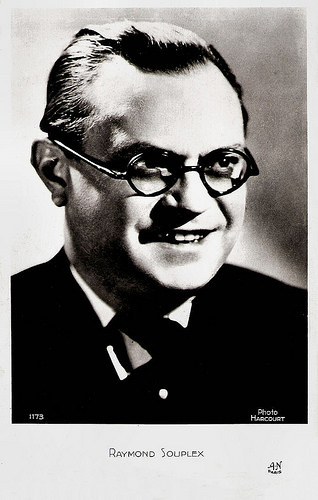
French postcard by A.N., Paris, no. 1173. Photo: Harcourt.
Philosophically minded tramps on a park bench
Raymond Souplex was born as Raymond Guillermain in 1901 in Paris. He was the son of a public servant and the youngest of four children. In 1920, he tried to enter the Conservatoire but failed.
But while he studied law and his first job as a clerk, he composed songs and wrote sketches. He became a singer and performed in the cabarets and dinner theatres in Paris. In this period he met Jane Sourza who became his accomplice for many years and not his girlfriend as was long believed.
From 1935, he participated in radio broadcasts of Radio Cité with Noël-Noël, Saint-Granier and Jane Sourza. With the latter, he played a pair of philosophically minded tramps on a park bench in the comedy show Sur le banc (The bench).
In 1954, Robert Vernay made the film Sur le banc, based on this radio show. Souplex played again the lead role of the tramp opposite Jane Sourza and Julien Carette. James Travers at Films de France : “Unlike the radio show that inspired it, the film version of Sur le banc was never going to end up a classic, but the combined talents of Souplex and Sourza, pepped up with a generous dash of Julien Carette, make it a pleasing enough timewaster on a dull afternoon.”
Raymond Souplex’ film career had started in 1939 with the film Sur le plancher des vaches/On dry land (Pierre-Jean Ducis, 1939) with Noël-Noël . At the time, Souplex had already become quite popular. During the Second World War, he continued to perform on stage, on the radio and in films.
In Les Surprises de la radio/The Surprises of the radio (Marcel Aboulker, 1940), he played himself in the middle of other big French stars of the era. He also participated with artists like Fréhel and Lys Gauty, in a tour along the factories of the Third Reich where many French people had to labour forced by the Service du travail obligatoire (Compulsory Work Service; STO). He got a reprimand for this tour after the Liberation.
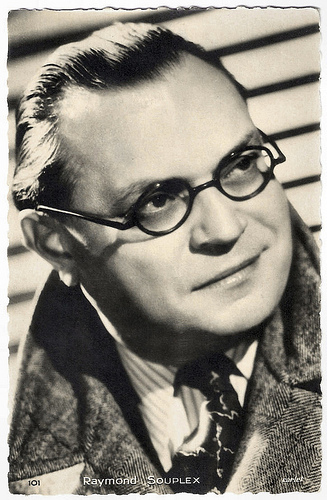
French postcard by Ed. Chantal, Rueil, no. 101. Photo: Carlet.
The five last minutes
After the war, Raymond Souplex resumed his show Sur le banc (The bench), now for Radio Luxembourg, from 1949 till 1963. He returned to the screen in Henri-Georges Clouzot’s Manon (1948) alongside Cécile Aubry , Serge Reggiani and Michel Bouquet.
Actor/journalist/screenwriter Henri Jeanson chose him to play an aging crooner in Lady Paname (Henri Jeanson, 1950) alongside Louis Jouvet and Suzy Delair .
In 1957, Claude Loursais gave him the lead role in the French television series Les Cinq Dernières Minutes/The Five Last Minutes, in which he played the police inspector (from 1965 on Commissioner) Antoine Bourrel. This Columbo-like role was inspired by the thriller Identité judiciaire/Paris Vice Squad (Hervé Bromberger, 1951) in which he played an identical character.
The collaboration with Claude Loursais lasted 56 episodes from 1958 to 1972. In the series Bourrel is assisted by inspector Dupuy, played by Jean Daurand. The two actors became so popular that they also appeared together as a police tandem in two films: L'assassin viendra ce soir/The assassin will come tonight (Jean Maley, 1964) and La Malédiction de Belphégor/The Curse of Belphegor (Georges Combret, Jean Maley, 1967) with Dominique Boschero .
In 1972, Raymond Souplex died in Paris of lung cancer at the age of 71. The filming of the fifty-sixth episode of Les Cinq Dernières Minutes was not finished yet. This episode would never be completed. A square in the 18th arrondissement of Paris, where Souplex has long lived on the corner of Montcalm and Marcadet street now bears his name. His wife died in 1993 and their daughter Perrette Souplex is also an actress.
Jane Sourza and Souplex as the tramps Carmen and La Hurlette in Sur le banc. Source: Chaîne de holdabaum (YouTube). Sorry, no subtitles.
Jean Daurand as Dupuy and Souplex as Bourrel in the episode Dans le pétrin/In trouble (Claude Loursais, 1959) of Les Cinq Dernières Minutes/The Five Last Minutes. Source: Cripure Louis (YouTube). Sorry, no subtitles.
Sources: James Travers (Films de France), Hal Erickson (AllMovie), Wikipedia (French and English) and .

French postcard by A.N., Paris, no. 1173. Photo: Harcourt.
Philosophically minded tramps on a park bench
Raymond Souplex was born as Raymond Guillermain in 1901 in Paris. He was the son of a public servant and the youngest of four children. In 1920, he tried to enter the Conservatoire but failed.
But while he studied law and his first job as a clerk, he composed songs and wrote sketches. He became a singer and performed in the cabarets and dinner theatres in Paris. In this period he met Jane Sourza who became his accomplice for many years and not his girlfriend as was long believed.
From 1935, he participated in radio broadcasts of Radio Cité with Noël-Noël, Saint-Granier and Jane Sourza. With the latter, he played a pair of philosophically minded tramps on a park bench in the comedy show Sur le banc (The bench).
In 1954, Robert Vernay made the film Sur le banc, based on this radio show. Souplex played again the lead role of the tramp opposite Jane Sourza and Julien Carette. James Travers at Films de France : “Unlike the radio show that inspired it, the film version of Sur le banc was never going to end up a classic, but the combined talents of Souplex and Sourza, pepped up with a generous dash of Julien Carette, make it a pleasing enough timewaster on a dull afternoon.”
Raymond Souplex’ film career had started in 1939 with the film Sur le plancher des vaches/On dry land (Pierre-Jean Ducis, 1939) with Noël-Noël . At the time, Souplex had already become quite popular. During the Second World War, he continued to perform on stage, on the radio and in films.
In Les Surprises de la radio/The Surprises of the radio (Marcel Aboulker, 1940), he played himself in the middle of other big French stars of the era. He also participated with artists like Fréhel and Lys Gauty, in a tour along the factories of the Third Reich where many French people had to labour forced by the Service du travail obligatoire (Compulsory Work Service; STO). He got a reprimand for this tour after the Liberation.

French postcard by Ed. Chantal, Rueil, no. 101. Photo: Carlet.
The five last minutes
After the war, Raymond Souplex resumed his show Sur le banc (The bench), now for Radio Luxembourg, from 1949 till 1963. He returned to the screen in Henri-Georges Clouzot’s Manon (1948) alongside Cécile Aubry , Serge Reggiani and Michel Bouquet.
Actor/journalist/screenwriter Henri Jeanson chose him to play an aging crooner in Lady Paname (Henri Jeanson, 1950) alongside Louis Jouvet and Suzy Delair .
In 1957, Claude Loursais gave him the lead role in the French television series Les Cinq Dernières Minutes/The Five Last Minutes, in which he played the police inspector (from 1965 on Commissioner) Antoine Bourrel. This Columbo-like role was inspired by the thriller Identité judiciaire/Paris Vice Squad (Hervé Bromberger, 1951) in which he played an identical character.
The collaboration with Claude Loursais lasted 56 episodes from 1958 to 1972. In the series Bourrel is assisted by inspector Dupuy, played by Jean Daurand. The two actors became so popular that they also appeared together as a police tandem in two films: L'assassin viendra ce soir/The assassin will come tonight (Jean Maley, 1964) and La Malédiction de Belphégor/The Curse of Belphegor (Georges Combret, Jean Maley, 1967) with Dominique Boschero .
In 1972, Raymond Souplex died in Paris of lung cancer at the age of 71. The filming of the fifty-sixth episode of Les Cinq Dernières Minutes was not finished yet. This episode would never be completed. A square in the 18th arrondissement of Paris, where Souplex has long lived on the corner of Montcalm and Marcadet street now bears his name. His wife died in 1993 and their daughter Perrette Souplex is also an actress.
Jane Sourza and Souplex as the tramps Carmen and La Hurlette in Sur le banc. Source: Chaîne de holdabaum (YouTube). Sorry, no subtitles.
Jean Daurand as Dupuy and Souplex as Bourrel in the episode Dans le pétrin/In trouble (Claude Loursais, 1959) of Les Cinq Dernières Minutes/The Five Last Minutes. Source: Cripure Louis (YouTube). Sorry, no subtitles.
Sources: James Travers (Films de France), Hal Erickson (AllMovie), Wikipedia (French and English) and .
Published on July 09, 2015 22:00
Paul van Yperen's Blog
- Paul van Yperen's profile
- 13 followers
Paul van Yperen isn't a Goodreads Author
(yet),
but they
do have a blog,
so here are some recent posts imported from
their feed.



